This course is from edX, scroll down click “Read More” for original course.
About this course
Discover the power of business blockchains and distributed ledger technologies with an overview of Hyperledger andits key frameworks. All over the global market there are ledgers that organizations and individuals alike must trust. Blockchain technologies record promises, trades, transactions or simply items we never want to disappear, allowing everyone in an ecosystem to keep a copy of the common system of record.
This introductory course is carefully curated for nontechnical, business-oriented audiences. It examines blockchains for the enterprise and a number of pertinent use cases from Hyperledger, a global cross-industry community of communities hosted by The Linux Foundation and advancing business blockchain technologies. Hyperledger is incubating and promoting enterprise grade, open source business blockchain software, on top of which anyone can set up apps to meet cross-industry needs.
The course covers key features of blockchain technologies and the differentiators between various types of Hyperledger projects. We’ll start with ‘what is blockchain’ and open the discussion to identifying suitable blockchain use cases for your business requirements. We will then take a deeper dive into the enterprise-ready Hyperledger blockchain frameworksand tools.
Students will gain an understanding of how blockchains work and how they can create value for their business through cost-savings and efficiencies, in terms of speed and simplicity. They will view how information is generated, stored, and shared in various blockchains, as well as gain tools to evaluate whether or not a blockchain solution would be suitable for their particular business case.
Industries today are usingblockchain technologies to increase efficiency and solve business problems associated with data privacy, security, information sharing, and inclusion. Be on the cutting edge; learn about these innovative technologiesand bring unique value to your business.
What you’ll learn
- Describe Business Blockchain and Distributed Ledger Technologies
- Gain familiarity with current Hyperledger projects and cross-industryuse cases
- Become involved in and contribute to the open source Hyperledger projects
Syllabus
Welcome!
Discovering Blockchain Technologies
Introduction to Hyperledger
Hyperledger Frameworks
Hyperledger Tools
The Promise of Business BlockchainTechnologies
What’s Next
Final Exam
Welcome!
Video: A Word from Brian Behlendorf, Executive Director at Hyperledger
Video: Inspiration Behind the Course (Brian Behlendorf)
Chapter 1. Discovering Blockchain Technologies
Introduction
Chapter 1 introduces the building blocks of distributed ledger technologies, including blockchains. It lays the foundation for an in-depth understanding of the content that follows in the course. You should engage with the content in this chapter both to learn, as well as brush up your blockchain knowledge.
Learning Objectives
By the end of this chapter, you should be able to:
- Explain the concepts of blockchain and distributed ledger technologies (DLT).
- Explore permissioned and permissionless blockchains and their key characteristics.
- Discuss various components of distributed ledger technologies, including consensus algorithms and smart contracts.
- Provide a high-level explanation of what Hyperledger is.
Background – The Rising Interest in Distributed Ledger Technologies
Looking back to the last half century of computer technologies and architectures, you may observe a trend of fluctuation between the centralization and subsequent decentralization of computing power, storage, infrastructure, protocols, and code.
Mainframe computers are largely centralized. They typically house all computing power, memory, data storage, and code. Access to mainframes is mainly by “dumb terminals”, which only take inputs and outputs, and do not store or process data.
With the advent of personal computers and private networks, similar computational capabilities were now housed both on the clients, as well as the servers. This, in part, gave rise to the “client-server” architecture, which supported the development of relational database systems. Massive data sets, which are housed on mainframes, could move onto a distributed architecture. This data could replicate from server to server, and subsets of the data could be accessed and processed on clients, and then, synced back to the server.
Over time, Internet and cloud computing architectures enabled global access from a variety of computing devices; whereas mainframes were largely designed to address the needs of large corporations and governments. Even though this “cloud architecture” is decentralized in terms of hardware, it has given rise to application-level centralization (e.g. Facebook, Twitter, Google, etc.).
Currently, we are witnessing the transition from centralized computing, storage, and processing to decentralized architectures and systems. According to Muneeb Ali, these systems aim to
“give explicit control of digital assets to end-users and remove the need to trust any third-party servers and infrastructure”.
Distributed ledger technology is one of the key innovations making this shift possible.
Distributed Ledger Technology (DLT)
A distributed ledger is a type of data structure which resides across multiple computer devices, generally spread across locations or regions.
Distributed ledger technology (DLT) includes blockchain technologies and smart contracts. While distributed ledgers existed prior to Bitcoin, the Bitcoin blockchain marks the convergence of a host of technologies, including timestamping of transactions, Peer-to-Peer (P2P) networks, cryptography, and shared computational power, along with a new consensus algorithm.
In summary, distributed ledger technology generally consists of three basic components:
- A data model that captures the current state of the ledger
- A language of transactions that changes the ledger state
- A protocol used to build consensus among participants around which transactions will be accepted, and in what order, by the ledger.
Video: Blockchain Technology (Robert Schwentker) Bookmark this page
Blockchains
According to hyperledger.org,
“A blockchain is a peer-to-peer distributed ledger forged by consensus, combined with a system for “smart contracts” and other assistive technologies. Together these can be used to build a new generation of transactional applications that establishes trust, accountability, and transparency at their core, while streamlining business processes and legal constraints.”
Smart contracts are simply computer programs that execute predefined actions when certain conditions within the system are met.
Consensus refers to a system of ensuring that parties agree to a certain state of the system as the true state.
Blockchains (Continued)
Blockchain is a specific form or subset of distributed ledger technologies (DLTs), which constructs a chronological chain of blocks, hence the name “block-chain”. Examples of other DLTs are Chain Core, Corda, Quorum, and IOTA. They will be covered later in this chapter.
A block refers to a set of transactions that are bundled together and added to the chain at the same time.
Timestamping is another key feature of blockchain technology. Each block is timestamped, with each new block referring to the previous block. Combined with cryptographic hashes, this timestamped chain of blocks provides an immutable record of all transactions in the network, from the very first (or genesis) block.
In the Bitcoin blockchain, the miner nodes bundle unconfirmed and valid transactions into a block. Each block contains a given number of transactions. In the Bitcoin network, miners must solve a cryptographic challenge to propose the next block. This process is known as “proof of work”, and requires significant computing power. We shall discuss proof of work in more detail in the Consensus Algorithms section. For more information about blockchain technology, please read the following article: “A Brief History of Blockchain” by Vinay Gupta.
A Bitcoin block consists of four pieces of metadata:
- The reference to the previous block
- The proof of work, also known as a nonce
- The timestamp
- The Merkle tree root for the transactions included in this block (Merkle tree is explained next).
Merkle Tree
The Merkle tree, also known as a binary hash tree, is a data structure that is used to store hashes of the individual data in large datasets in a way to make the verification of the dataset efficient. It is an anti-tamper mechanism to ensure that the large dataset has not been changed. The word “tree” is used to refer to a branching data structure in computer science, as seen in the image below. According to Andreas M. Antonopoulos, in the Bitcoin protocol,
“Merkle trees are used to summarize all the transactions in a block, producing an overall digital fingerprint of the entire set of transactions, providing a very efficient process to verify whether a transaction is included in a block“.
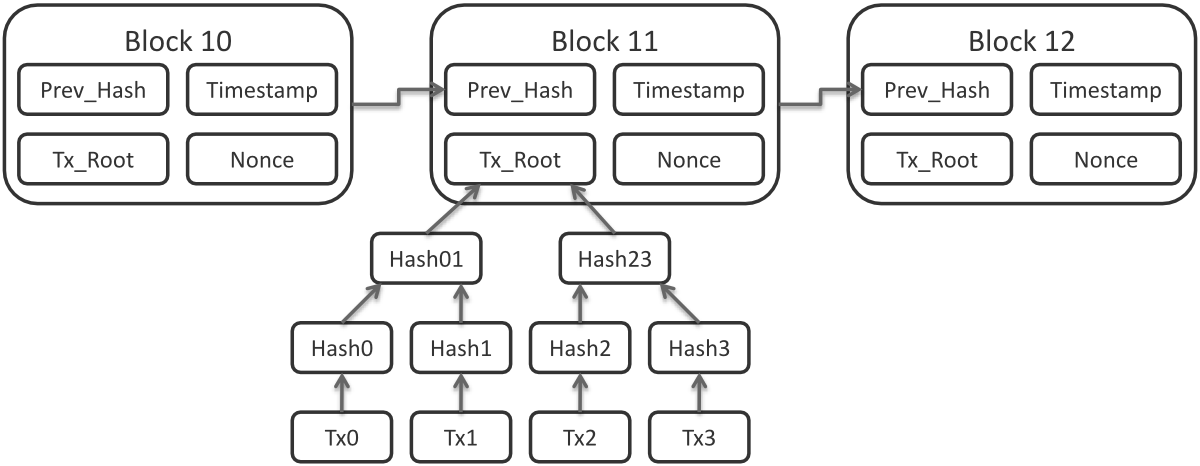
Bitcoin Block Data
(licensed under Creative Commons Attribution-Share-Alike 3.0 Unported, retrieved from Wikipedia)
Video: What Is a Blockchain? (Dave Huseby)
Transactions
The record of an event, cryptographically secured with a digital signature, that is verified, ordered, and bundled together into blocks, form the transactions in the blockchain. In the Bitcoin blockchain, transactions involve the transfer of bitcoins, while in other blockchains, transactions may involve the transfer of any asset or a record of some service being rendered. Furthermore, a smart contract within the blockchain may allow automatic execution of transactions upon meeting predefined criteria.
Cryptography has a key role to play both in the security, as well as in the immutability of the transactions recorded on blockchains. Cryptography is the study of the techniques used to allow secure communication between different parties and to ensure the authenticity and immutability of the data being communicated. For blockchain technologies, cryptography is used to prove that a transaction was created by the right person. It is also used to link transactions into a block in a tamper-proof way, as well as create the links between blocks, to form a blockchain.
Differences Between Blockchains and Databases
Blockchain technology has some key differentiators from databases.
A blockchain is a write-only data structure, where new entries get appended onto the end of the ledger. Every new block gets appended to the blockchain by linking to the previous block’s “hash” (you can check the Glossary tab for a refresher on hash functions). There are no administrator permissions within a blockchain that allow editing or deleting of data.
In a relational database, data can be easily modified or deleted. Typically, there are database administrators who may make changes to any part of the data and/or its structure. Additionally, blockchains were designed for decentralized applications, whereas relational databases, in general, were originally designed for centralized applications, where a single entity controls the data.

Types of Blockchains
A blockchain can be both permissionless (like Bitcoin or Ethereum) or permissioned (like the different Hyperledger blockchain frameworks). A permissionless blockchain is also known as a public blockchain, because anyone can join the network. A permissioned blockchain, or private blockchain, requires pre-verification of the participating parties within the network, and these parties are usually known to each other.

The choice between permissionless versus permissioned blockchains should be driven by the particular application at hand (or use case). Most enterprise use cases involve extensive vetting before parties agree to do business with each other. An example where a number of businesses exchange information is supply chain management. The supply chain management is an ideal use case for permissioned blockchains. You would only want trusted parties participating in the network. Each participant that is involved in the supply chain would require permissions to execute transactions on the blockchain. These transactions would allow other companies to understand where in the supply chain a particular item is.
On the contrary, when a network can “commoditize” trust, facilitating parties to transact without necessarily having to verify each other’s identity, like the Bitcoin blockchain, a permissionless blockchain is more suitable. Many of these instances involve the sale or distribution to the public. Cryptocurrencies and Initial Coin Offerings (which are not backed by national governments) usually involve implementations of permissionless blockchains.
You will learn about a variety of use cases in Chapter 5, “The Promise of Business Blockchain Technologies”.
Peer-to-Peer Network Architecture
Historically, most applications utilize a central server (or servers). For one user/client to send a message to another user/client in the network, the request has to be sent to the hub or a central server, which then directs it to the right computer.
Peer-to-peer (P2P) networks were first made popular by Napster (and later BitTorrent) and consist of computer systems which are directly connected to each other via the Internet, without a central server. Peers contribute to the computing power and storage that is required for the upkeep of the network. P2P networks are generally considered to be more secure than centralized networks, as they do not have a single point of attack, as in the case of a server-based network, where the security of the entire network can be compromised if the central server is successfully attacked. The Global Risks Report 2018, created by the World Economic Forum, reveals a grim picture: cyberattacks are on the rise at an alarming rate, and financial costs related to them are skyrocketing, with more than 25% increase year-over-year. It is estimated that cybercrime will cost businesses more than $8 trillion over the next five years. And the damages go far beyond financial costs: they affect critical, strategic infrastructure, such as telecommunications providers, energy companies, government agencies, banks, hospitals, and much more. As a result, large corporations and federal governments invest significant amounts of financial resources to fortify their central servers.
Permissionless P2P systems do not require a set amount of peers to be online and are generally slower. Permissioned P2P networks have to guarantee uptime and require a high level of quality of service on the communication links.
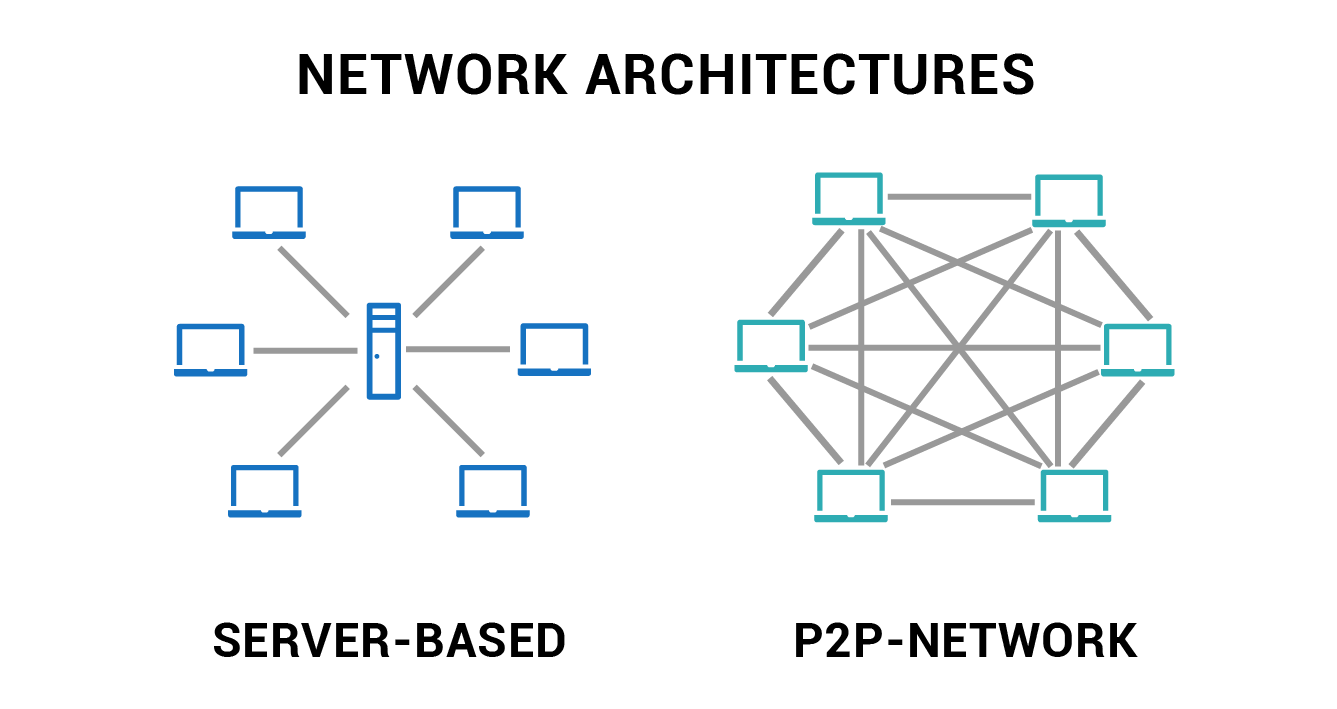
Video: Peer-to-Peer Networks (Robert Schwentker)
Blockchain Applications
Since blockchain is a form of digital infrastructure, applications built on top of a blockchain provide a gateway to accessing information that sits on that blockchain. In other words, clients/users interact with the blockchain through applications. Starting from the simple wallets that hold bitcoins, sophisticated applications which encompass applications addressing digital identity (e.g. UPort, KYC-Chain, Netki, etc.), and complex financial transactions are being built on the blockchain.
A more exhaustive list of companies using blockchain technology for identity management and authentication can be found in the following article: “21 Companies Leveraging Blockchain for Identity Management and Authentication” by Elena Mesropyan.
For more details about blockchain applications, you can refer to Daniel Palmer’s article entitled “7 Cool Decentralized Apps Being Built on Ethereum“.
Video: Smart Contracts (Robert Schwentker)
Smart Contracts
Smart contracts are simply computer programs that execute predefined actions when certain conditions within the system are met. Smart contracts provide the language of transactions that allow the ledger state to be modified. They can facilitate the exchange and transfer of anything of value (e.g. shares, money, content, property).

Bitcoin – A Popular Blockchain Deployment
With the invention of the peer-to-peer (P2P) cash system known as Bitcoin in 2008, we have an example of a global decentralized payment network with a distributed and publicly-owned infrastructure, operating as a “permissionless” system. There is a persuasive case that Bitcoin is the first “killer application” of decentralized computing. One can send and receive bitcoins anywhere in the world in a completely P2P manner, without having to intermediate through a trusted third party, such as a bank.
According to the Coin Market Capitalizations website, as of May 2019, bitcoin’s market capitalization (market cap) was over $95 billion.
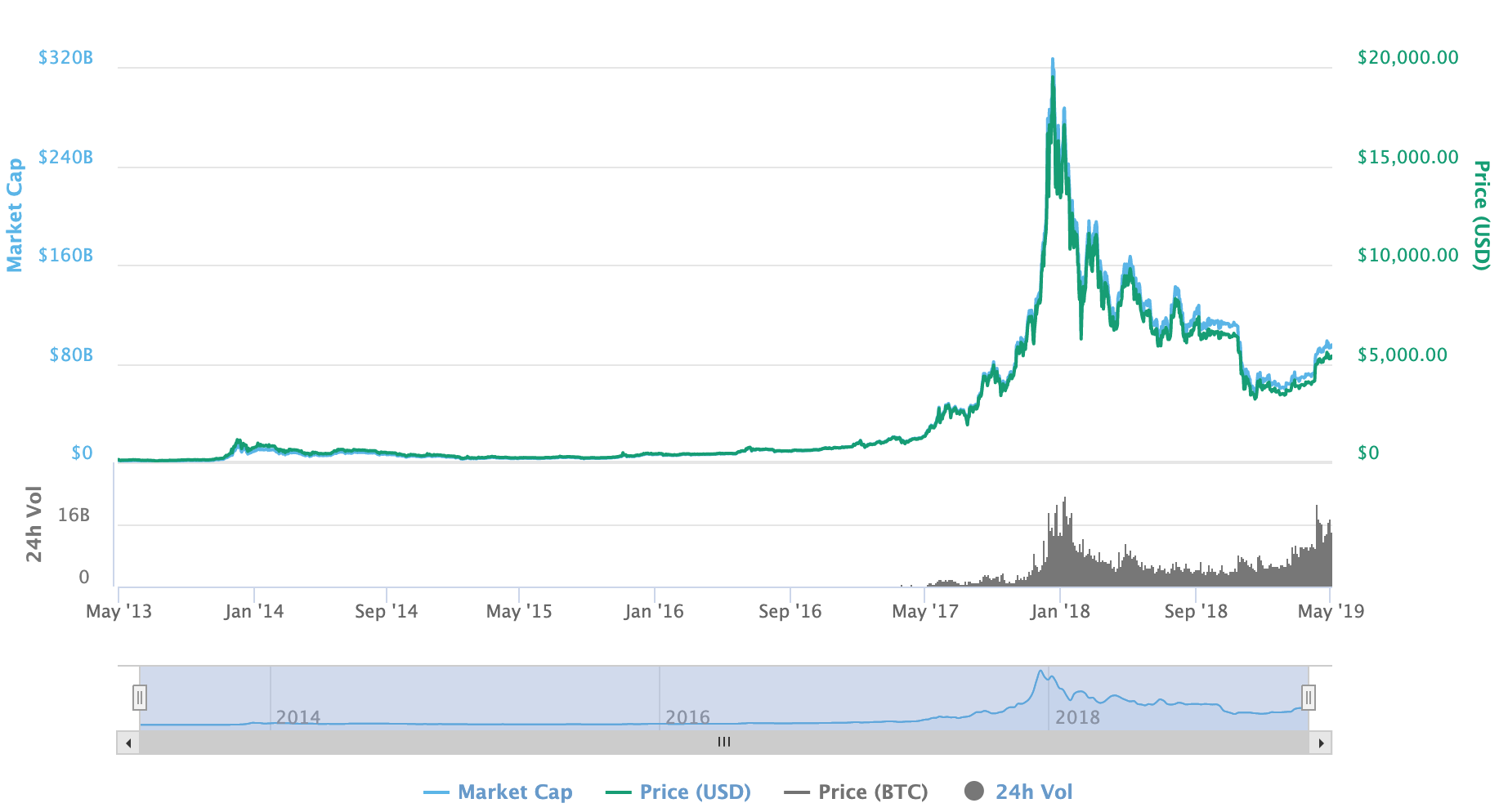
Bitcoin Charts
(Source: https://coinmarketcap.com/currencies/bitcoin/)
According to AngelList, over three thousand startups have been created to leverage Bitcoin and blockchain-related technologies since the inception of the Bitcoin payment system. Hundreds of large companies, and dozens of governments and universities have become actively involved in researching, testing, and prototyping blockchain protocols, platforms, and applications. In particular, the financial services sector has been actively investing in exploring wider applications of distributed ledger technologies (of which, blockchain is a subset) since late 2015.
Video: Bitcoin and Ethereum (Robert Schwentker)
Bitcoin and Cryptoeconomics
Bitcoin has also ushered in tremendous academic and research interest in the area of Cryptoeconomics and Cryptoeconomic security.
According to Vitalik Buterin,
“Cryptoeconomics is about building systems that have certain desired properties using cryptography to prove properties about messages that happened in the past while using economic incentives defined inside the system to encourage desired properties to hold into the future”.
In other words, the field of Cryptoeconomics explores the intersection of cryptography and economic incentives. While cryptography is used for ensuring network security at various levels and functions, the built-in economic incentives provided to the participating nodes in the network ensures that, at any given point, the majority of players in the network operate in a desirable way.
Rather than imposing barriers to entry, permissionless blockchains are public and open for anyone to join. Since such networks can reasonably expect all kind of agents – including malicious actors – the key lies in incentivizing good behavior in a critical majority of the network, such that:
- The malicious actors cannot take over the network through an escalated attack.
- The malicious actors cannot collude to undertake an organized majority attack on the network.
- The payoffs of securing the network are consistently higher than the cost of attacking the network.
- The cost of attacking the network is prohibitively high.
You can find more about Cryptoeceonomics read “The Blockchain Economy: A Beginner’s Guide to Institutional Cryptoeconomics“.
Ethereum – An Alternative to Bitcoin
According to Ethereum’s official documentation,
“Ethereum is an open blockchain platform that lets anyone build and use decentralized applications that run on blockchain technology”.
The Ethereum blockchain platform facilitates scripting functionality, or “smart contracts”, which are run through the nodes in the network. As a result, unlike the Bitcoin blockchain, it does not just track transactions, it also programs them. Technically, Ethereum is a Turing-complete virtual machine with its native cryptocurrency called “ether”. The platform was proposed in 2013 in a white paper by the then 19-year old Vitalik Buterin.
As of May 2019, Ethereum had a market cap of over $17 billion, making Ether the second most valuable cryptocurrency after Bitcoin.
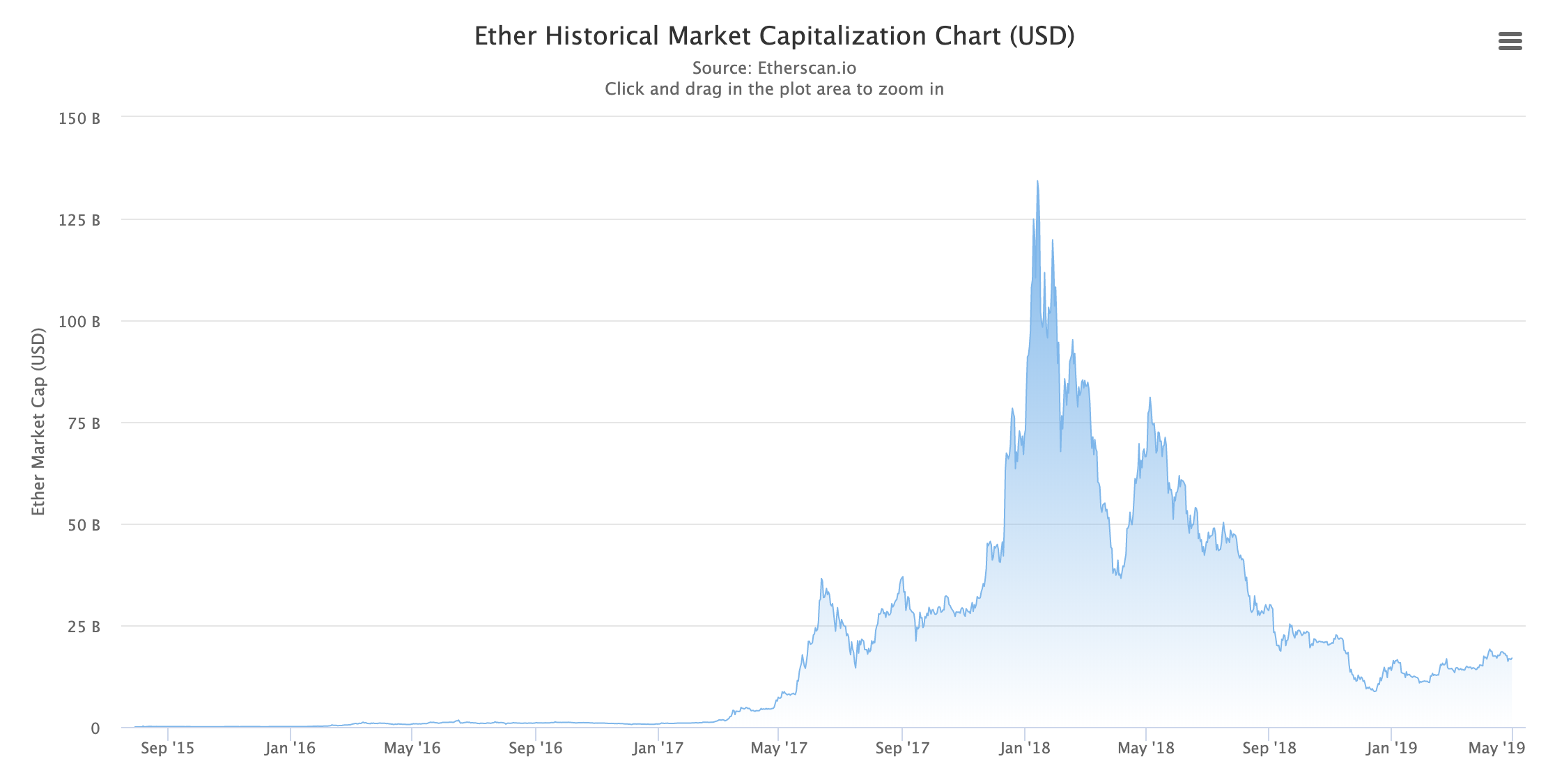
Ether Historical Market Capitalization Chart
(Source: https://etherscan.io/chart/marketcap)
As the second best known public blockchain after the Bitcoin blockchain, Ethereum has ushered in an era of unprecedented activity around blockchain and distributed ledger technology.
Video: Ethereum (Robert Schwentker)
Dapps
As Stephan Tual explains, Ethereum applications do not have a middleman; instead, users interact in a P2P fashion with other users through a variety of interfaces – social, financial, gaming, etc. Since the applications are developed on the decentralized consensus-based network itself, third-party censorship is virtually impossible. Malicious actors cannot secretly tamper with the application by changing the code and compromise all application users (or nodes that are actively interacting with it). These Decentralized Applications have come to be known as Dapps.
Since they are cryptographically secured, Dapps are referred to as “secure applications”. Some of the high profile Dapps built on the Ethereum platform include:
The Ethereum network is a distributed global public network, which means it is not run on central servers in a certain geographical location. Instead, the computing power that runs the network is contributed by nodes that are spread across the globe. In other words, Dapps have “zero downtime” – they never go down and, in general, cannot be switched off.
Ethereum Smart Contracts
A hypothetical example of an Ethereum-based smart contract may involve the following transaction: in an equity raise, transfer amount X from the investor to the company upon receiving the given shares from the company. The monetary amount X, which was pre-validated by the company for the transaction (much like in a credit card purchase), is held in escrow by the smart contract, until the shares have been received by the investor. Any kind of arbitrary sophisticated business logic can be committed to the blockchain. The Ethereum blockchain only encodes these “rules of the games”. The actual payoffs occur by interacting with the blockchain.
The illustration below describes this process. The smart contract encodes the agreement between the company raising funds and its investors (Panel 1). The smart contract sits on the Ethereum public blockchain, and is run on the Ethereum Virtual Machine (EVM). Once hitting a triggering event, like an expiration date or a strike price that has been pre-coded, the smart contract automatically executes as per the business logic (Panel 2). As an added benefit, regulators are able to scrutinize the market activity on an ongoing basis, without compromising the identity of specific players in a permissionless public blockchain, as Ethereum (Panel 3).
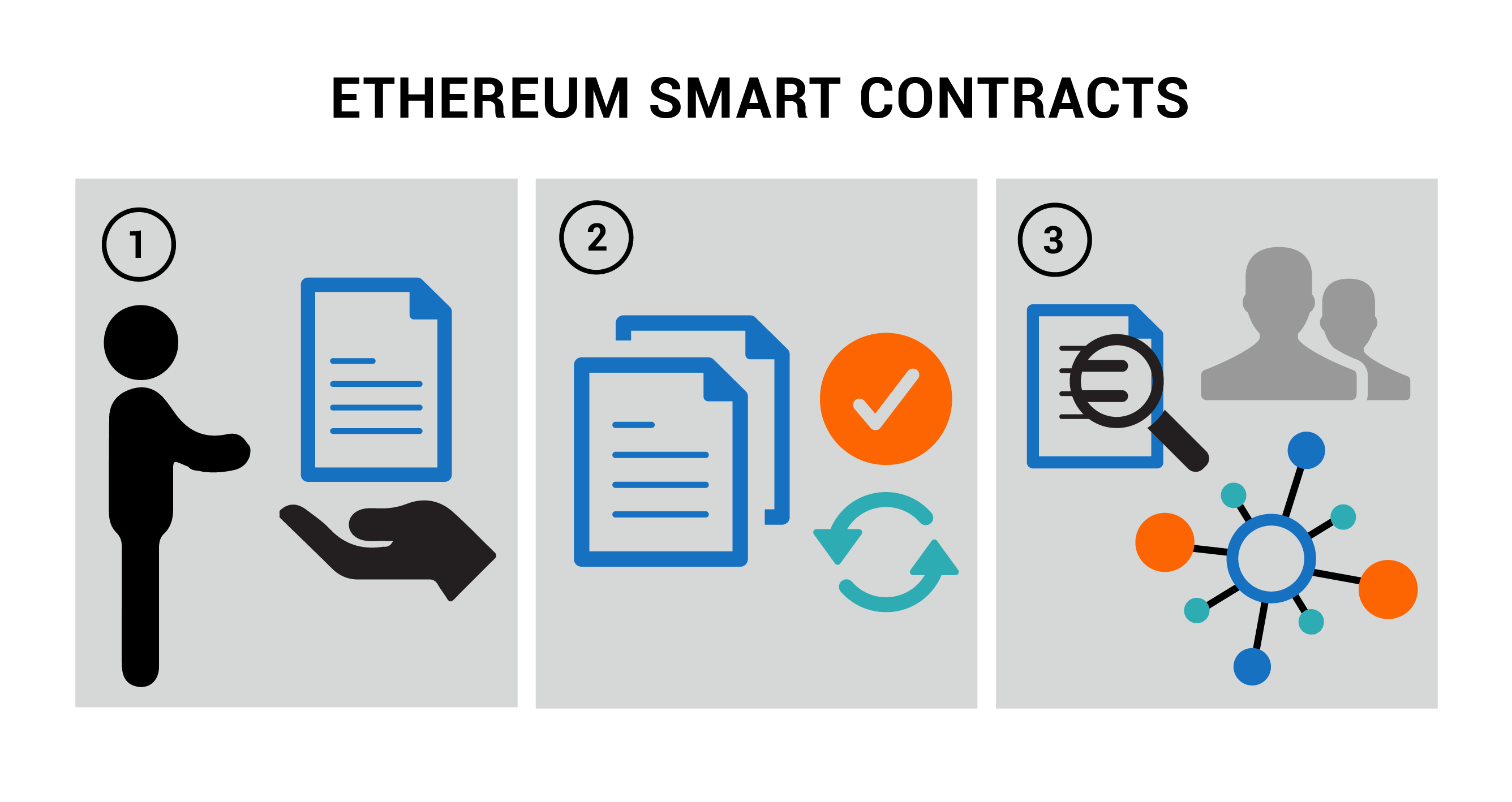
Note: With the advent of the Ethereum blockchain platform and the scripting functionality or smart contracts that it enables, there are ongoing attempts to do the same for the Bitcoin blockchain, which does not allow for this, due to security reasons. RSK is one such smart contract platform that seeks to achieve this “with a 2-way peg to Bitcoin”. The added functionality can go a long way in making the Bitcoin blockchain useful for use cases other than cash transfers.
Exploring Permissionless Blockchains
We will examine the Bitcoin and Ethereum blockchains, both of which are permissionless, public blockchains. We will examine several large transactions, and the genesis block for each blockchain. We will look at block heights, transaction times, mining pools, timestamps, and block rewards.
Video: Exploring Bitcoin and Ethereum Blockchains
Consensus Algorithms
Consensus in the network refers to the process of achieving agreement among the network participants as to the correct state of data on the system. Consensus leads to all nodes sharing the exact same data. A consensus algorithm, hence, does two things: it ensures that the data on the ledger is the same for all the nodes in the network, and, in turn, prevents malicious actors from manipulating the data. The consensus algorithm varies with different blockchain implementations.
While the Bitcoin blockchain uses Proof of Work as the consensus algorithm, other blockchains and distributed ledgers are deploying a variety of consensus algorithms, like the Proof of Stake, Proof of Burn, Proof of Capacity, Proof of Elapsed Time, and many others, depending on their unique requirements.
Next, we will briefly explain some of these algorithms.
Proof of Work (PoW)
The Proof of Work consensus algorithm involves solving a computational challenging puzzle in order to create new blocks in the Bitcoin blockchain. Colloquially, the process is known as ‘mining’, and the nodes in the network that engage in mining are known as “miners”. The incentive for mining transactions lies in economic payoffs, where competing miners are rewarded with 12.5 bitcoins and a small transaction fee.
As described in the 2016 Kudelski Security report,
“Proof-of-work (PoW) is the outcome of a successful mining process and, although the proof is hard to create, [it] is easy to verify”.
For better understanding, please consider the following example provided by Ofir Beigel:
“(…) guessing a combination to a lock is a proof to a challenge. It is very hard to produce this since you will need to guess many different combinations; but once produced, it is easy to validate. Just enter the combination and see if the lock opens”.
Multiple criticisms exist for the PoW consensus algorithm. PoW requires a huge amount of energy to be expended, given the computationally heavy algorithm. In addition, PoW has a high latency of transaction validation, and the concentration of mining power is located in countries where electricity is cheap. In terms of the network security, PoW is susceptible to the “51% attack”, which refers to an attack on a blockchain by a group of miners controlling more than 50% of the network’s computing power.
Proof of Stake (PoS)
The Proof of Stake algorithm is a generalization of the Proof of Work algorithm. In PoS, the nodes are known as the “validators” and, rather than mining the blockchain, they validate the transactions to earn a transaction fee. There is no mining to be done, as all coins exist from day one. Simply put, nodes are randomly selected to validate blocks, and the probability of this random selection depends on the amount of stake held. So, if node X owns 2 coins and node Y owns 1 coin, node X is twice as likely to be called upon to validate a block of transactions. The specific implementation of PoS can vary, depending on the use case, or as a matter of software design. Instances include Proof of Deposit and Proof of Burn. The PoS algorithm saves expensive computational resources that are spent in mining under a PoW consensus regime.
Proof of Elapsed Time (PoET)
Developed by Intel, the Proof of Elapsed Time consensus algorithm emulates the Bitcoin-style Proof of Work. Hyperledger’s Sawtooth implementation is an example of PoET at work. Instead of competing to solve the cryptographic challenge and mine the next block, as in the Bitcoin blockchain, the PoET consensus algorithm is a hybrid of a random lottery and first-come-first-serve basis. In PoET, each validator is given a random wait time.
“The validator with the shortest wait time for a particular transaction block is elected the leader”.
– sawtooth.hyperledger.org
This “leader” gets to create the next block on the chain.
Simplified Byzantine Fault Tolerance (SBFT)
The Simplified Byzantine Fault Tolerant consensus algorithm implements an adopted version of the Practical Byzantine Fault Tolerant (PBFT) algorithm, and seeks to provide significant improvements over Bitcoin’s Proof of Work consensus protocol. The basic idea involves a single validator who bundles proposed transactions and forms a new block. Note that, unlike the Bitcoin blockchain, the validator is a known party, given the permissioned nature of the ledger. Consensus is achieved as a result of a minimum number of other nodes in the network ratifying the new block. In order to be tolerant of a Byzantine fault, the number of nodes that must reach consensus is 2f+1 in a system containing 3f+1 nodes, where f is the number of faults in the system. For example, if we have 7 nodes in the system, then 5 of those nodes must agree if 2 of the nodes are acting in a faulty manner.
The practical example would be that of ByzCoin, which seeks to make key improvements over the original Bitcoin protocol. Addressing the challenge around scalability due to high latency, ByzCoin transactions are irreversibly committed to the blockchain within seconds. The added advantage is the communication trees to “(…) optimize transaction commitments and verification under normal operations“ (2016 Kudelski Security report).
Proof of Authority (PoA)
Proof-of-Authority (PoA) is a consensus algorithm which can be used for permissioned ledgers. It uses a set of “authorities”, which are designated nodes that are allowed to create new blocks and secure the ledger. Ledgers using PoA require sign-off by a majority of authorities in order for a block to be created.
Comparing Permissioned Consensus Approaches and Standard PoW
Consensus can be implemented in different ways, such as through the use of lottery-based algorithms (PoET or PoW), or through the use of voting-based methods (SBFT), each targeting different network requirements and fault tolerance models.
Lottery-based algorithms are advantageous in that they can scale to a large number of nodes. Voting-based algorithms provide low-latency finality.
The following table offers an at-a-glance view of the main considerations and pros and cons of different business blockchain approaches to reaching consensus.
Permissioned | Permissioned | Standard Proof of Work | |
Speed | ***** GOOD | ***** | * |
Scalability | ***** | *** | ***** |
Finality | *** | ***** | * |
Hyperledger
Hyperledger is an open source effort created to advance cross-industry blockchain technologies. Hosted by The Linux Foundation, it is a global collaboration of members from various industries, including finance, banking, Internet of Things (IoT), supply chain, manufacturing, healthcare and more. Hyperledger boasts a host of enterprise-ready solutions. Hyperledger is about communities of software developers building blockchain frameworks and platforms. We will take a closer look at some of the current Hyperledger projects in the coming chapters.
“One of the first things people learn when coming to Hyperledger is that Hyperledger isn’t, like its name may imply, a ledger. It is a collection of blockchain technology projects.”
Dan Middleton, All Are Welcome Here (2018)
Video: Hyperledger (Robert Schwentker)
Hyperledger Blockchains: Permissioned or Permissionless?
Hyperledger blockchains are generally permissioned blockchains, which means that the parties that join the network are authenticated and authorized to participate on the network. Hyperledger’s main goal is to create enterprise grade, open source, distributed ledger frameworks and code bases to support business use cases.
Advantages of Using a Permissioned Blockchain over a Permissionless Blockchain
If you look at permissionless blockchains, like the Bitcoin blockchain or the Ethereum blockchain, anyone can join the network, as well as write and read transactions. The actors in the system are not known, which means there could be some malicious actors within the network.
Hyperledger reduces these security risks and ensures that only the parties that want to transact are the ones that are part of the transaction and, rather than displaying the record of the transactions to the whole network, they remain visible only to the parties involved. So, Hyperledger provides all the capabilities of the blockchain architecture – data privacy, information sharing, immutability, with a full stack of security protocols – all for the enterprise. Permissioned blockchains offer more efficient transaction performance, thus being highly scalable, and have a clearly defined governance structure.
Video: Hyperledger vs. Other Permissioned Ledgers (Brian Behlendorf)
Video: Other Distributed Ledger Technologies (Robert Schwentker)
Chain Core
Chain Core is an enterprise permissioned blockchain system that is mostly focused on financial services, like currencies, securities, derivatives, gift cards, and loyalty points. The company partners with clients to launch and operate a network under the client’s brand. Thanks to its strategic partnerships with companies such as Capital One, Citigroup, Fiserv, Nasdaq, Orange, Visa, etc., the company raised over $40 million in funding since 2014.
Within the Chain Core network, the creation and transfer of assets is decentralized. However, as stated in the 2016 Kudelski Security report,
“the operation of the network is governed by a designated set of entities known as a federation”.
The platform features the Chain Testnet, which allows decentralized application development on Chain Core, operated by Chain, Microsoft, and the Initiative for Cryptocurrencies and Contracts (IC3).
Corda
R3 is an enterprise blockchain software firm that works with over three hundred members and partners across multiple industries, that seeks to leverage distributed ledger technologies to record, manage, and automate legal agreements between businesses through its software solution, called Corda.
Launched in 2016, Corda is an open source distributed ledger platform, which features a blockchain-style P2P network; however, it is not a blockchain platform. Unlike blockchains, which involve global availability of data across the network and third party validators, Corda only allows information access and validation functions to parties actually involved in the transaction. Featuring a different software architecture, “Corda achieves consensus between firms at the level of individual deals, not the level of the system” (Richard Gendal Brown, 2016), while supporting a variety of consensus mechanisms.
Quorum
Created by JPMorgan, Quorum is, in fact, a fork of the Ethereum public blockchain, which uses a voting-based consensus algorithm to facilitate an enterprise-focused distributed ledger and smart contract platform. Data privacy is achieved within the network by allowing data visibility on a need-to-know basis. This open source blockchain platform is designed to support “both transaction-level privacy and network-wide transparency”. The network validates all smart contracts and overall system state through the involvement of all running nodes. As with other permissioned ledgers, regulatory compliance is front and center in the Quorum platform.
IOTA
IOTA is an open source permissionless distributed ledger technology that has been around since 2015; it has a cryptocurrency called mIOTA. According to Martin Rosulek, “It is the first cryptocurrency that provides the whole ecosystem based on blockless blockchain” to enable machine-to-machine (M2M) transactions.
IOTA, however, is more than just a cryptocurrency. Essentially, the platform entails a generalization of the blockchain protocol (the technology called Tangle) that sits at the backend of the IOTA platform. The platform uses a Decentralized Acyclic Graph (DAG) instead of a blockchain to store its ledger.
Instead of paying miners to validate the transactions, the architecture of the network involves peer-based validation. We can think of a simple analogy, that of a teacher grading students’ homework: the students are the clients/users in the Bitcoin protocol, and the teacher is the miner/validator. Tangle technology asks students (users) to grade each other’s homework, making the need for a teacher (external validator) redundant, and avoiding expenses related to the teacher’s/validator’s work. This allows the platform to be completely free of cost, without facing the scaling challenges that are inherent in the first generation of blockchains.
Additionally, the use of the platform with connected devices or the Internet of Things
“enables companies to explore new business-to-business models by making every technological resource a potential service to be traded on an open market in real time, with no fees”.
– Roger Aitken, 2017
IOTA focuses mainly on enabling the emerging Internet of Things (IoT), but also plans to go beyond this, on being the transaction settlement and data integrity layer for the Internet of Everything (IoE).
Challenges in the Adoption/Deployment of Distributed Ledger Technologies
There are a number of challenges to the widespread use of permissioned distributed ledger technologies. Key among them are challenges around the lack of standards, regulatory challenges, and the lack of knowledge about distributed ledger technologies. These challenges are inherent to any new technological infrastructure that replaces an older infrastructure.
Other challenges encountered when it comes to the adoption and deployment of distributed ledger technologies are:
- Resistance to change
- Scalability concerns
- Interoperability and integration with legacy systems
- Unproven business case
- Lack of capital to fund new investments
- System complexity and costs.
We hope you go on to address some of these challenges and contribute to building a secure digital future!
Standards
Since we are still witnessing the early days of blockchain technology, there is very little agreement on standards in the developer and business community, as of yet. Standards are key in ensuring interoperability and avoiding risks associated with a fragmented ecosystem. Standards are critical not just for the distributed ledger itself, but also for supporting services, like identity, privacy, and data governance. Furthermore, the management of keys, as well as protocols and standards around key loss and theft, will be critical (Deshpande, Stewart, Lepetit, & Gunashekar, 2017).
As a result, the International Organization for Standardization for Blockchain and Distributed Ledger Technologies was established in 2016 and has defined areas for future standardization work (Clare Naden, 2017). More about the ISO/TC 307 technical committee can be found at the ISO/TC 307 website.
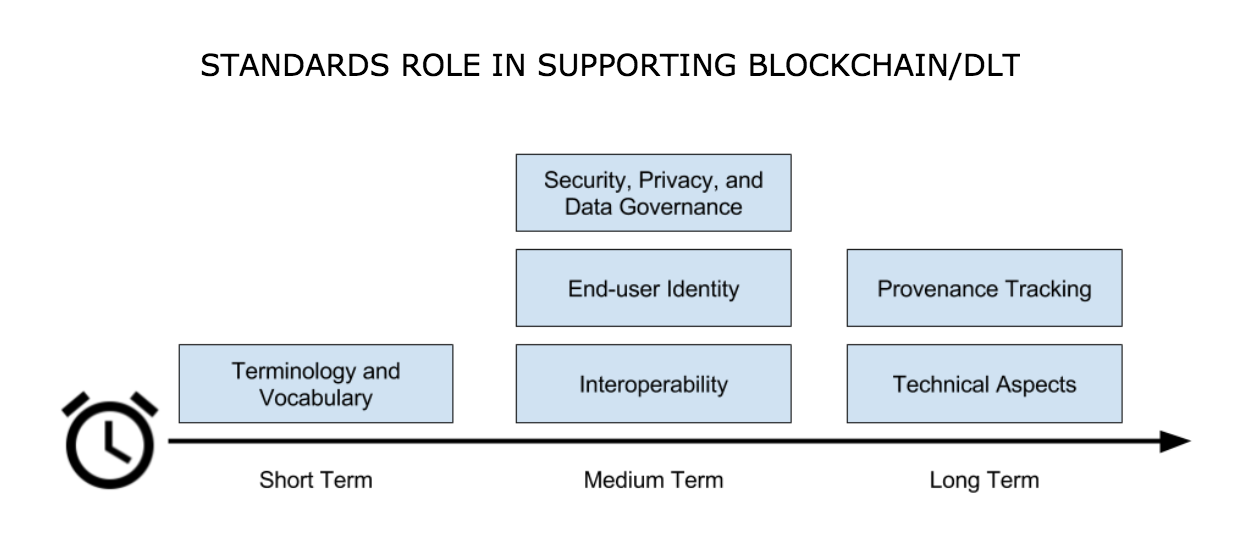
Regulation
The lack of regulation around transactions on the blockchain creates an environment of uncertainty for all players. Highly regulated industries like financial services are treading carefully in the DLT space. The Securities and Exchange Commission of the United States has clarified its stance on Initial Coin Offerings (ICOs) in 2017. The Chinese government has, in fact, banned all ICOs, while 60 major ICO platforms are being investigated (Saheli Roy Choudhury, 2017).
Similarly, there are no regulatory guidelines governing smart contracts, causing much anxiety among various players like lawyers, regulators, programmers, and businesses. The lack of regulatory guidelines, along with a lack of industry standards, exacerbates hindrances to rapid adoption of DLT.
Lack of Know-How
The lack of know-how (and know-whom and know-where) around distributed ledger technologies and the availability of experts in the area is a major challenge in the adoption of distributed ledger technologies. While there has been an exponential increase in the interest around ‘blockchain’, as indicated in the figure below, there is a huge lag of technical talent in the space. In fact, the origin of this course stems from the need to address this gap in know-how.
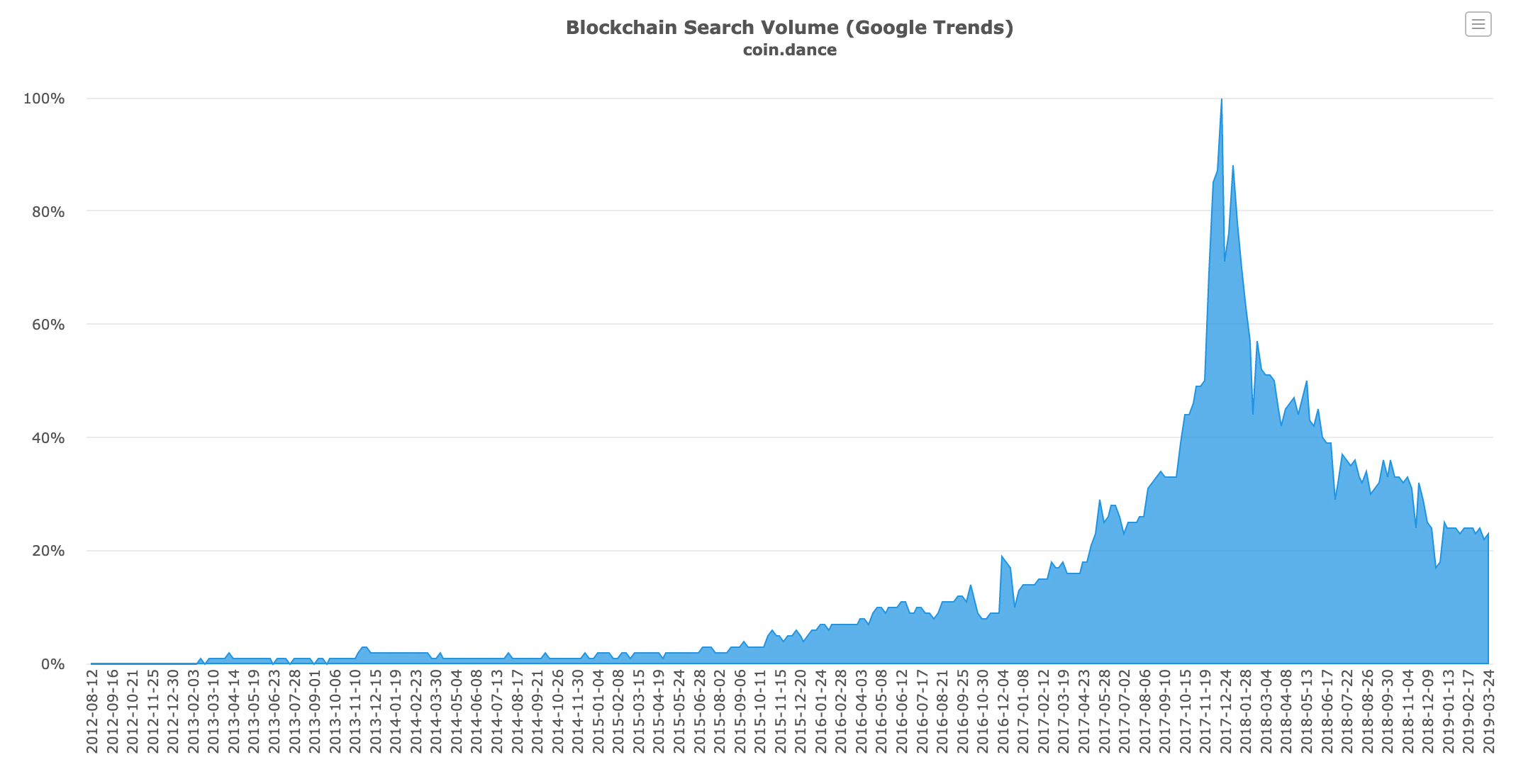
Blockchain Search Volume
Retrieved from https://coin.dance/stats/blockchain on May 7, 2019
Jobs in the blockchain development space are among the top 20 fastest growing, and the number of positions available increased over 200% in 2018 over those available the previous year. However, there is not a large enough pool of qualified blockchain developers, and this is a major concern. The emergence of more and more blockchain training courses and certifications is aiming to slowly close this gap.
Learning Objectives (Review)
You should now be able to:
- Discuss blockchain and distributed ledger technologies (DLT).
- Explore permissioned and permissionless blockchains and their key characteristics.
- Discuss various components of distributed ledger technologies, including consensus algorithms and smart contracts.
- Provide a high-level explanation of what Hyperledger is.
Conclusions
For a new technology to realize its full potential, a lot of pieces need to exist before network effects can be realized. Moreover, in order for the technology to bring in systemic efficiencies, a critical mass needs to be attained. As an infrastructure technology, all major players in the market need to collaborate to define standards in a democratic manner. The blockchain community is indeed witnessing unprecedented levels of industry collaboration between players who are otherwise competitors in the space. Because of the cost of moving from one infrastructure technology to the next, an open source collaborative approach is the most promising way forward. As you will learn in Chapter 2, “Introduction to Hyperledger“, Hyperledger’s mandate is to develop and nurture this ecosystem to develop the future of business blockchain technologies.
Chapter 2. Introduction to Hyperledger
Introduction
This chapter provides an overview of Hyperledger, a collaborative project hosted by The Linux Foundation that is focused on business blockchain technologies. It also provides a brief introduction to the projects advanced under the Hyperledger greenhouse, as of May 2019.
Learning Objectives
By the end of this chapter, you should be able to:
- Explain the differences between Hyperledger and permisionless blockchain technologies.
- Discuss how Hyperledger leverages open standards and open governance to support business solutions.
- List Hyperledger frameworks (Iroha, Sawtooth, Fabric, Indy, Burrow, and Grid) and tools (Aries, Cello, Explorer, Composer, Caliper, Quilt, Transact and Ursa).
Video: Hyperledger (Navroop Sahdev)
Hyperledger
Hyperledger incubates and promotes a range of business blockchain technologies, including distributed ledger frameworks, smart contract engines, client libraries, graphical interfaces, utility libraries, and sample applications. Hosted by The Linux Foundation, collaborators include industry leaders in technology, finance, banking, supply chain management, manufacturing, and IoT.
As of May 2019, there are 14 projects in the Hyperledger greenhouse, six of which are distributed ledger frameworks. The other eight projects are tools that support these frameworks. The diagram below does not reflect two of the tools, Hyperledger Aries and Hyperledger Transact (as they were just added to the Hyperledger greenhouse at the time we worked on the course).

As Arnaud Le Hors, member of the Hyperledger Technical Steering Committee, emphasized,
“these projects show how broadly applicable blockchain technology really is. This goes way beyond cryptocurrencies”.
Hyperledger provides an alternative to the cryptocurrency-based blockchain model, and focuses on developing blockchain frameworks and tools to support global enterprise solutions. The focus of Hyperledger is to provide a transparent and collaborative approach to blockchain development.
Video: The Birth of Hyperledger (Brian Behlendorf)
Comparing Hyperledger with Bitcoin and Ethereum
The following table explores the differences between Hyperledger’s permissioned distributed ledgers and the Bitcoin and Ethereum permissionless blockchains. If you are considering blockchain solutions for your business requirements, it is important to pay attention to all these elements and weigh in on those that are most important for your use case.
Bitcoin | Ethereum | Hyperledger Frameworks | |
Cryptocurrency-based | Yes | Yes | No |
Permissioned | No | No | Yes (in general)* |
Pseudo-anonymous | Yes | No | No |
Auditable | Yes | Yes | Yes |
Immutable ledger | Yes | No | No |
Modularity | No | No | Yes |
Smart contracts | No | Yes | Yes |
Consensus Protocol | PoW | PoW | Various** |
*Sawtooth can be configured to be permissionless.
**Key Hyperledger consensus protocols are Apache Kafka in Hyperledger Fabric, PoET and RAFT in Hyperledger Sawtooth, RBFT (Plenum) in Hyperledger Indy, Tendermint in Hyperledger Burrow, and Yet Another Consensus (YAC) in Hyperledger Iroha. For more details, see the Hyperledger Architecture, Volume 1 paper.
Hyperledger Goals
Hyperledger has taken a leadership role to develop cross-industry standards and provide a neutral space for software collaboration. The financial services industry, in particular, is witnessing an unprecedented level of collaboration between institutions that have traditionally been competitors. The advent of a new foundational or infrastructural technology like the blockchain – much like the Internet – requires collaboration of various actors in order to realize the full benefits of the technology. Unless all actors use a certain standard, the pace of technological dissemination will continue to be slow. Technological adoption is characterized by network effects, where the costs decrease with the increase in use of a certain technology. Since shifting to distributed ledger technology involves significant costs, open source software, communities and ecosystems that develop around these have a significant part to play.
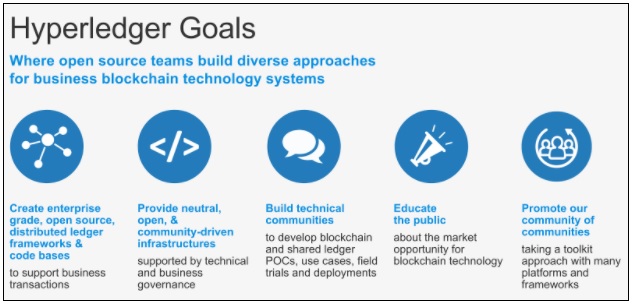
Video: The Importance of Open Source (Brian Behlendorf)
Open Standards
“Only an Open Source, collaborative software development approach can ensure the transparency, longevity, interoperability and support required to bring blockchain technologies forward to mainstream commercial adoption. That is what Hyperledger is about – communities of software developers building blockchain frameworks and platforms”.
– hyperledger.org
As we learned in Chapter 1: “Discovering Blockchain Technologies“, the non-availability of standards in distributed ledger technologies is one of the major hurdles in scaling them. One of Hyperledger’s key goals is to facilitate the process of standards formation, not by promoting its own distributed ledger(s), but by providing a space for a variety of standards to co-exist simultaneously:
“Rather than declaring a single blockchain standard, it encourages a collaborative approach to developing blockchain technologies via a community process, with intellectual property rights that encourage open development and the adoption of key standards over time”.
– hyperledger-fabric.readthedocs.io
Hyperledger aims to adhere to “open standards”, which means they are
“(…) interoperable through open published interfaces and services”.
– John Palfreyman, ibm.com
Open Source and Open Standards
The Enterprise Ethereum Alliance (EEA) and Hyperledger formally joined each other’s organizations as Associate Members in October 2018. This strategic partnership aims to grow the blockchain ecosystem by enabling “active and mutual cross-community collaboration through event participation, connecting with other members, and finding ways for our respective efforts to be complementary and compatible.”
- EEA promotes the development of specifications and standards for enterprise blockchain networks
- Hyperledger advances the development of open source software for establishing, managing and connecting enterprise blockchain networks.
This announcement came as a confirmation of an already fruitful collaboration between the two organizations; some examples of this collaboration:
- Hyperledger Burrow is an implementation of the Ethereum Virtual Machine (EVM) bytecode interpreter
- Hyperledger Sawtooth support for the EVM as a transaction processor (Seth)
- Hyperledger Fabric support for the EVM
- The existence of an EEA working group on Trusted Execution Environments, along with a prototype implementation of the proposed standards, Private Data Objects, built as a lab at Hyperledger.
“…simultaneously developing community-driven open standards and production-quality open source reference implementations is a best practice of Internet-scale software development work.”
While working together, the two organizations will also continue to collaborate with other standard bodies and open source communities, all with the common goal of accelerating the adoption of enterprise blockchain technologies.
Open Source and Open Governance
“Today, most people understand the concept of Open Source. What many people don’t get, and something we here at Hyperledger and The Linux Foundation pride ourselves on doing well, is Open Governance“.
– hyperledger.org
Open source software is software that is made freely available and may be redistributed and modified. In other words, anyone has the ability to view the code, use the code, copy the code, change the code, and, depending on the open source license, contribute back changes.
Open governance means that technical decisions for an open source project are made by a group of community-elected developers drawn from a pool of active participants. These decisions include things such as which features to add, how, and when to add them.
To learn more about the specifics of Hyperledger’s open governance read the following article “ABCs of Open Governance“.
Video: Software Governance of the Hyperledger Projects (Brian Behlendorf)
Strength Through Diversity
As you familiarize yourself more with Hyperledger and the blockchain technologies it fosters in its greenhouse, you will notice the similarities between some of its projects, but most importantly, what differentiates them from one another and the use cases they were designed to address. The idea behind this approach was and continues to be that there is no one solution to address the myriad of needs, requirements and use cases.
“Having a portfolio of projects, though, enables us to have the variety of ideas and contributors to become a strong open source community… It’s not that our multiplicity of projects has given us strength through numbers, but rather strength through diversity.”
Dan Middleton, All Are Welcome Here (2018)
Video: Blockchain Security at Hyperledger (David Huseby)
Video: How Will Hyperledger Change the Blockchain Ecosystem? (Brian Behlendorf)
Blockchain for Business
The cryptocurrency-based blockchain model, popularized by public blockchains like Bitcoin and Ethereum, currently falls short of fulfilling a host of requirements that many types of organizations would have to fulfill in order to be compliant when using blockchain and distributed ledger technologies – for instance, in the areas of financial services, healthcare, and government.
Hyperledger is a unique platform that is developing permissioned distributed ledger frameworks specifically designed for enterprises, including those in industries with strong compliance requirements. Enterprise use cases require capabilities such as scalability and throughput, built-in or interoperable identity modules for the parties involved in a transaction or a network, or even access to regulators who can access all data in the ledger as read-only to ensure compliance. The latter is particularly important because, regardless of the innovation, it has to operate within the current regulatory framework, as well as comply with any new rules that come into place specifically targeted at blockchain technologies.
The enterprise continues to be at the heart of this course.
Video: Why Businesses Choose to Use Hyperledger? (Brian Behlendorf)
Video: Hyperledger, A Greenhouse for Blockchain Projects
Q/A with Brian Behlendorf, Executive Director of Hyperledger
Before diving deeper into the projects advanced under the Hyperledger umbrella, we asked Brian Behlendorf, Executive Director of Hyperledger at The Linux Foundation, some questions.
Video: Reasons Why Developers Would Become Interested in Open Source Software
Video: Hyperledger vs. Apache
Video: Interoperability Between Hyperledger Frameworks
Learning Objectives (Review)
You should now be able to:
- Explain the differences between Hyperledger and permisionless blockchain technologies.
- Discuss how Hyperledger leverages open standards and open governance to support business solutions.
- List Hyperledger frameworks (Iroha, Sawtooth, Fabric, Indy, Burrow, and Grid) and tools (Aries, Cello, Explorer, Composer, Caliper, Quilt, Transact and Ursa).
Conclusions
Chapter 2 provided a general overview of Hyperledger, analyzing how this collaborative project leverages the advantages of open source standards and governance to support meaningful business solutions and accelerate adoption of blockchain technologies for business. We had the opportunity to discuss the differences between Hyperledger technologies (enterprise-grade, permissioned blockchain technologies) and permissionless (public) blockchain technologies.
In the next chapter we will focus on Hyperledger frameworks.
Chapter 3. Hyperledger Frameworks
Introduction
In this chapter, we will briefly explore the frameworks developed under the Hyperledger umbrella (as of May 2019), highlighting their key features and use cases. We will dive deeper in discussing use cases in the last chapter of this course.
Learning Objectives
By the end of this chapter, you should be able to:
- Define what a project is according to the Hyperledger documentation.
- Discuss the project lifecycle process adopted by Hyperledger, and the five possible states.
- List the components of Hyperledger frameworks.
- Get a high-level understanding of the Hyperledger frameworks: Hyperledger Burrow, Hyperledger Fabric, Hyperledger Grid, Hyperledger Indy, Hyperledger Iroha, and Hyperledger Sawtooth.
Hyperledger Incubator
According to the Hyperledger documentation, a project refers to a collaborative endeavor to deliver a work item. Projects can vary in terms of scope: some are intended to produce a document, some may develop new capabilities or refactor/remove an existing capability.
In general, open source initiatives use an incubation process for new work items: this allows members of the community to contribute new ideas and code in a more structured and transparent workflow. Hyperledger has adopted a rigorous project lifecycle process that has six possible states:
- Proposal
If an open source initiative wants to be hosted under the Hyperledger greenhouse, a proposal is submitted to the TSC for review. The proposal must have a clear description and a well-defined scope, must identify the development resources that are committed to the project, as well as the initial maintainers, and must be vendor neutral. - Incubation
Once a project proposal is approved, it enters the Incubation phase, and the community has a chance to explore different idea related to the project. When a project reaches a mature-enough stage and qualifies to be declared Active, the maintainers will vote to submit a graduation review request to the TSC. All projects ready to graduate from Incubation must have a fully functional code base, test coverage commensurate with other Active projects, an active and diverse community of developers, and a history of releases that follow the Active release process. A project in the Incubation stage is not guaranteed to eventually graduate – some projects never get to Active state. - Active
Projects that successfully exit the Incubation phase are considered Active. If reasons exist, an Active project can be deprecated. - First Major Release
If the maintainers of a project are looking to publish the project’s first major release, they will have to obtain approval from the TSC. - Deprecated
All deprecated projects are maintained for a six month period by their communities; after that, the projects are removed from subsequent formal releases. A deprecation notice is given to the public. After a six-month deprecation period, projects are labeled End of Life. - End of Life
These are projects that are no longer developed or maintained.
- Proposal
New projects wanting to join are evaluated on a number of things:
- How do they fit with the portfolio of other projects
- How mature are they, to understand where they’re going
- Who are the developers around the projects, etc.
When a project goes through a rigorous vetting process and graduates from the incubator, it signals to the public that they can now trust the code, that the code can be used to build applications upon it.
There are fourteen projects in the Hyperledger greenhouse, as of June 2019. And the door is open to new projects joining. There are four fully-fledged Hyperledger projects, that have graduated from the Incubator and are in an Active state (as of June 2019):
- Hyperledger Fabric (March 2017)
- Hyperledger Sawtooth (May 2017)
- Hyperledger Iroha (May 2018)
- Hyperledger Indy (March 2019).
The other projects are still working through the process, and the goal is to get every one of them out of the Incubator.
Components of Hyperledger Frameworks
Hyperledger business blockchain frameworks are used to build enterprise blockchains for a consortium of organizations. They are different than public ledgers like the Bitcoin blockchain and Ethereum. Hyperledger frameworks include:
- An append-only distributed ledger
- A consensus algorithm for agreeing to changes in the ledger
- Privacy of transactions through permissioned access
- Smart contracts to process transaction requests.
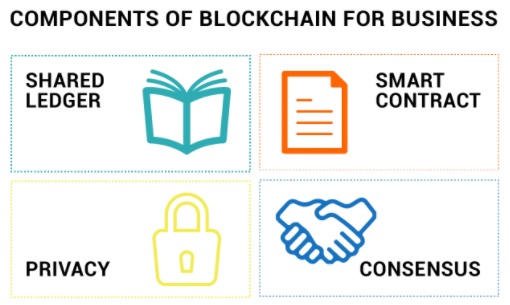
Now, let’s explore the Hyperledger frameworks (as of June 2019)!
Video: Hyperledger Burrow
Hyperledger Burrow
Hyperledger Burrow was released in December 2014. It was originally designed by Monax, and co-sponsored by Intel. The project is generally updated on a quarterly basis, and is licensed under the Apache 2.0. license. Currently under incubation, Hyperledger Burrow is a permissionable smart contract machine that provides a “modular blockchain client with a permissioned smart contract interpreter partially developed to the specification of the Ethereum Virtual Machine (EVM)”. It is the only available Apache-licensed EVM implementation. Hyperledger Burrow is not trying to be highly pluggable, nor hard to deploy.
Hyperledger Burrow components are:
- Consensus Engine – Hyperledger Burrow uses the Byzantine fault-tolerant Tendermint protocol to order and finalize transactions
- The API Gateway provides interfaces for systems integration and user interfaces
- The Smart Contract Application engine facilitates integration of complex business logic (maintaining the networking stack between the nodes and ordering transactions)
- Permissioned Ethereum Virtual Machine – it is built to observe the Ethereum operation code specification, and asserts the correct permissions have been granted
- Application Binary Interface (ABI) – transactions must be formulated in a binary format, which is processed by the blockchain node.
- The Application Blockchain Interface (ABCI) provides interface specification for the consensus engine and smart contract application engine to connect.

Video: Hyperledger Fabric
Hyperledger Fabric
Hyperledger Fabric is an open source, production ready, permissioned blockchain framework implementation that was designed to serve as a foundation for developing applications or solutions with a modular architecture. It was the first proposal for a codebase (2016), combining previous work done by Digital Asset Holdings, Blockstream’s libconsensus, and IBM’s OpenBlockchain. It graduated from the Hyperledger Incubator in March of 2017.
Key characteristics of Hyperledger Fabric are:
- High-performance, secure, permissioned blockchain network
- Features powerful container technology to host any mainstream language for smart contracts development
- Code written in Go, chaincode written in Go, Javascript, or Java, SDKs written in Node.js, Java, Go, RERT and Python.
Its modular architecture allows components such as consensus and membership services to be plug-and-play. One of the key advantages of Hyperledger Fabric is that it allows entities to conduct confidential transactions without passing information through a central authority. This is accomplished through different channels that run within the network, as well as the division of labor that characterizes the different nodes within the network.
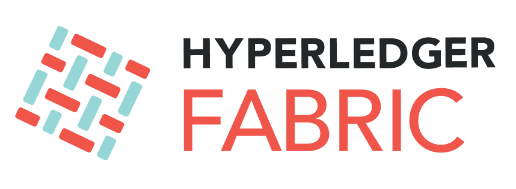
Hyperledger Grid
Hyperledger Grid is a platform for building supply chain solutions that include distributed ledger components; it’s an ecosystem of technologies, frameworks, and libraries that work together, allowing application developers to chose which components are best for their industry or market model. It intends to:
- Produce reference implementations of supply chain-centric data types, data models, and smart contract-based business logic based on existing open standards and industry best practices
- Provide authentic, practical ways to combine components from the Hyperledger Stack into a single, effective business solution.
Hyperledger Grid was acceppted in the Hyperledger Incubator as of December 2018, with Cargill, Intel and Bitwise as primary contributors to this initial stage. It’s software is licensed under the Apache License Version 2.0.

Video: Hyperledger Indy
Video: Hyperledger Indy (Nathan George)
Hyperledger Indy
Hyperledger Indy is a distributed ledger purpose-built for decentralized identity, that upholds the standards mandated by GDPR. Hyperledger Indy “provides tools, libraries, and reusable components for providing digital identities rooted on blockchains or other distributed ledgers so that they are interoperable across administrative domains, applications, and any other silo.”
Hyperledger Indy was contributed to the Hyperledger greenhouse by the Sovrin Foundation in 2017, and it graduated from the Incubator in March of 2019. It allows individuals to manage and control their digital identities. Rather than having businesses store huge amounts of personal data of individuals, Hyperledger Indy allows businesses to store pointers to identity. Once the company verifies the other party’s identity, it throws it away.
According to Brian Behlendorf,
“(…) identity is a toxic asset that could present a liability to organizations”.
Indeed, since 2013, over 14 billion data records were lost or stolen. What is striking is that, out of these, only 4% were encrypted, and hence, rendered useless after being stolen (also called “secure breaches”). You can find detailed statistics at the Breach Level Index website.

One of the key principles of Hyperledger Indy is its “privacy by design” approach. Given the immutable nature of the DLT, it is all the more important that digital identities be handled with the utmost care, keeping human values front and center.
“Hyperledger Indy lets users authenticate identity based on the attributes they are willing to store and share themselves. This can reduce the amount of liability contained within a business because the data can be kept with the user and presented to you again in a way that you can trust and validate that what has been said really was said and is trusted by the other parties you do business with”.
– Nathan George, Maintainer, Hyperledger Indy
Further information about the history of the project can be found at the Sovrin’s website.

Video: Hyperledger Iroha
Hyperledger Iroha
Hyperledger Iroha is a free, open source blockchain framework contributed by Soramitsu, Hitachi, NTT Data, and Colu (2016). Hyperledger Iroha is a simple blockchain platform that can be used to make trusted, secure, and fast applications that leverage the power of permission-based blockchain with Byzantine fault-tolerant consensus. Among its key features are:
- Simple deployment and maintenance
- Variety of libraries for developers
- Role-based access control
- Modular design, driven by command-query separation principle
- Ready-to-use set of commands and queries
- Multi-signature transactions
- Uses a high-performance Byzantine fault-tolerant consensus algorithm called YAC.
According to the Hyperledger Iroha documentation, “it can be used to manage digital assets, identity and serialized data, and can be useful for applications such as interbank settlement, central bank digital currencies, payment systems, national IDs, and logistics, among others”. Its documentation provides an extensive list of use cases, and specific advantages the use of Hyperledger Iroha can introduce – you can read about these use case scenarios online.
Hyperledger Iroha emphasizes mobile application development with client libraries for Android and iOS, making it distinct from other Hyperledger frameworks. Inspired by Hyperledger Fabric, Hyperledger Iroha seeks to complement Hyperledger Fabric and Hyperledger Sawtooth, while providing a development environment for C++ developers to contribute to Hyperledger.
Hyperledger Iroha is an active project, and reached a significant milestone in May 2019, the 1.0 release. To learn more about it, you can read the announcement.

Video: Hyperledger Sawtooth
Hyperledger Sawtooth
Hyperledger Sawtooth, is an open source blockchain framework that utilizes a highly modular platform for building, deploying, and running distributed ledger applications and networks, making smart contracts safe, particularly for enterprise use. It was originally contributed by Intel and joined the Hyperledger greenhouse in April of 2016. In May of 2018 it graduated from the Hyperledger Incubator. Some of its key characteristics are:
- Uses pluggable consensus algorithms, which allows consensus to be changed by transaction on the fly
- Smart contracts can be written in almost any language
- Parallel transaction execution for added throughput, while at the same time preventing double spending
- Ethereum contract support via Hyperledger Burrow integration
- No central authority or implementation. This increases security as there is no centralized service that could leak transaction patterns or any other confidential information
- Supports creating and broadcasting events.
Distributed ledger solutions built with Hyperledger Sawtooth can utilize various consensus algorithms based on the size of the network (PoET SGX, Raft, etc.). Hyperledger Sawtooth is designed for versatility, with support for both permissioned and permissionless deployments. This technology simplifies blockchain application development and deployment by clearly separating the core system from the application domain.
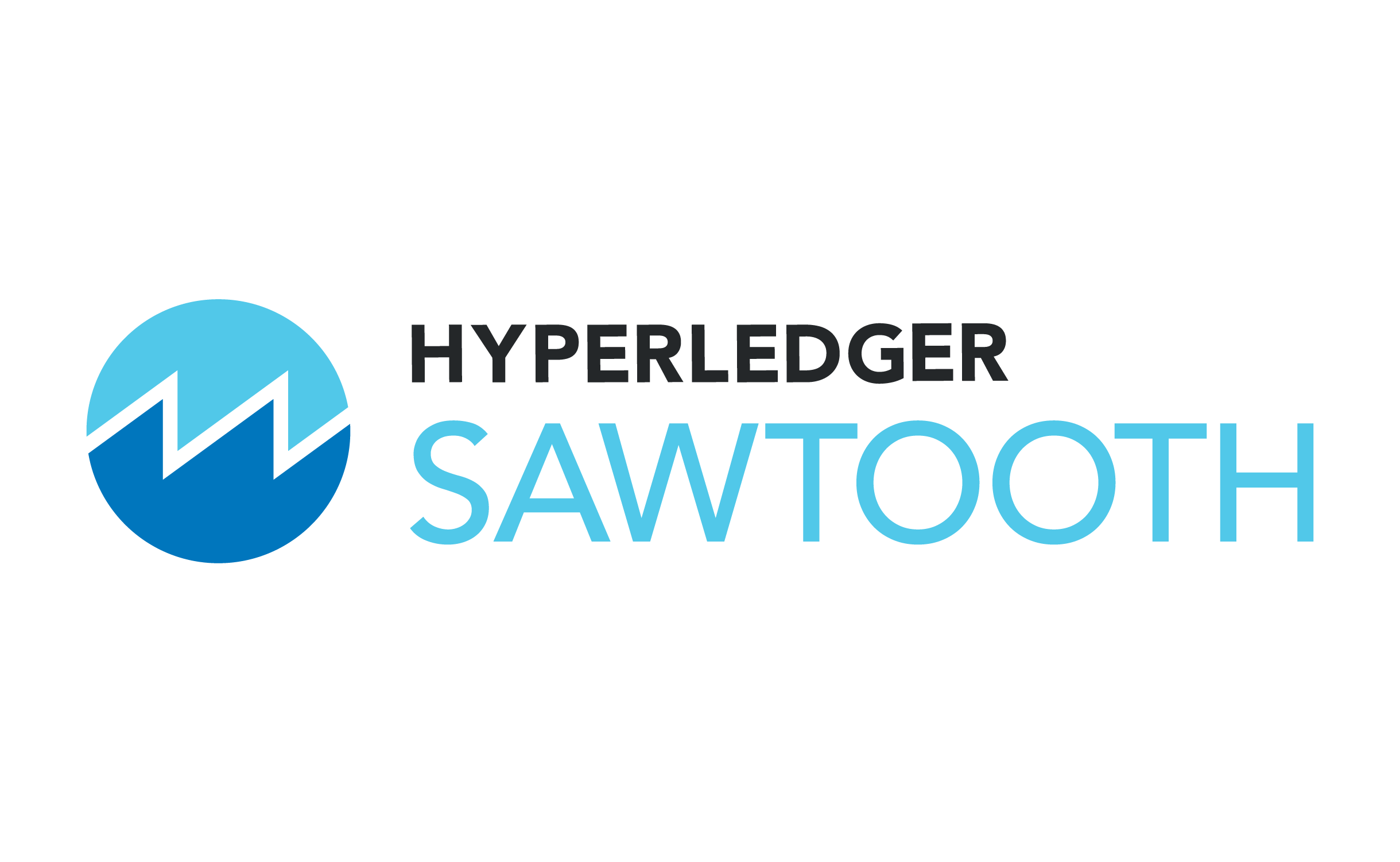
Video: Hyperledger Sawtooth Characteristics Relative to Use Cases (Dan Middleton)
Video: Hyperledger Sawtooth – Supply Chain Use Case Example (Courtesy of Sawtooth)
Learning Objectives (Review)
You should now be able to:
- Define what a project is according to the Hyperledger documentation.
- Discuss the project lifecycle process adopted by Hyperledger, and the five possible states.
- List the components of Hyperledger frameworks.
- Get a high-level understanding of the Hyperledger frameworks: Hyperledger Burrow, Hyperledger Fabric, Hyperledger Grid, Hyperledger Indy, Hyperledger Iroha, and Hyperledger Sawtooth.
Conclusions
In this chapter, we briefly explored the frameworks developed under the Hyperledger greenhouse (as of May 2019), highlighting their key features and use cases.
In the next chapter we will focus on Hyperledger tools.
Chapter 4. Hyperledger Tools
Introduction
The Hyperledger frameworks which we examined in the previous chapter are used to build blockchains and distributed ledgers. The Hyperledger tools, which we will look at next, are auxiliary softwares used for things like deploying and maintaining blockchains, examining the data on the ledgers, as well as tools to design, prototype, and extend blockchain networks.
Learning Objectives
By the end of this chapter, you should be able to:
- Understand the role of Hyperledger tools.
- Get a high-level understanding of the Hyperledger tools (as of May 2019): Hyperledger Aries, Hyperledger Caliper, Hyperledger Cello, Hyperledger Composer, Hyperledger Explorer, Hyperledger Quilt, Hyperledger Transact, and Hyperledger Ursa.
Hyperledger Aries
Hyperledger Aries “provides a shared, reusable, and interoperable tool kit designed for initiatives and solutions focused on creating, transmitting and storing verifiable digital credentials. It is infrastructure for blockchain-rooted, peer-to-peer interactions; it’s not a blockchain and it’s not an application. This open source project joined the Hyperledger greenhouse in May 2019 and was initially contributed by developers from the Sovrin Foundation, the Government of British Columbia, and other Indy community developers.
Hyperledger Aries is related to both Hyperledger Indy and Hyperledger Ursa (we will talk about this project later in this chapter). This project aims “to change the client layers in Hyperledger Indy to be interoperable with other identity projects. The ultimate goal of Hyperledger Aries is to provide a dynamic set of capabilities to store and exchange data related to blockchain-based identity. These capabilities will range from the secured, secret storage of data such as private keys, up to the capability of globally accessible data that can be viewed and accessed by anyone. An example of such support is the creation of a secure storage solution similar to the wallet available in Hyperledger Indy today.”
Hyperledger Aries developers aim to eventually have a scalable, searchable storage layer capable of storing other associated data necessary for identity maintenance, such as pictures, health records, or other personal information.
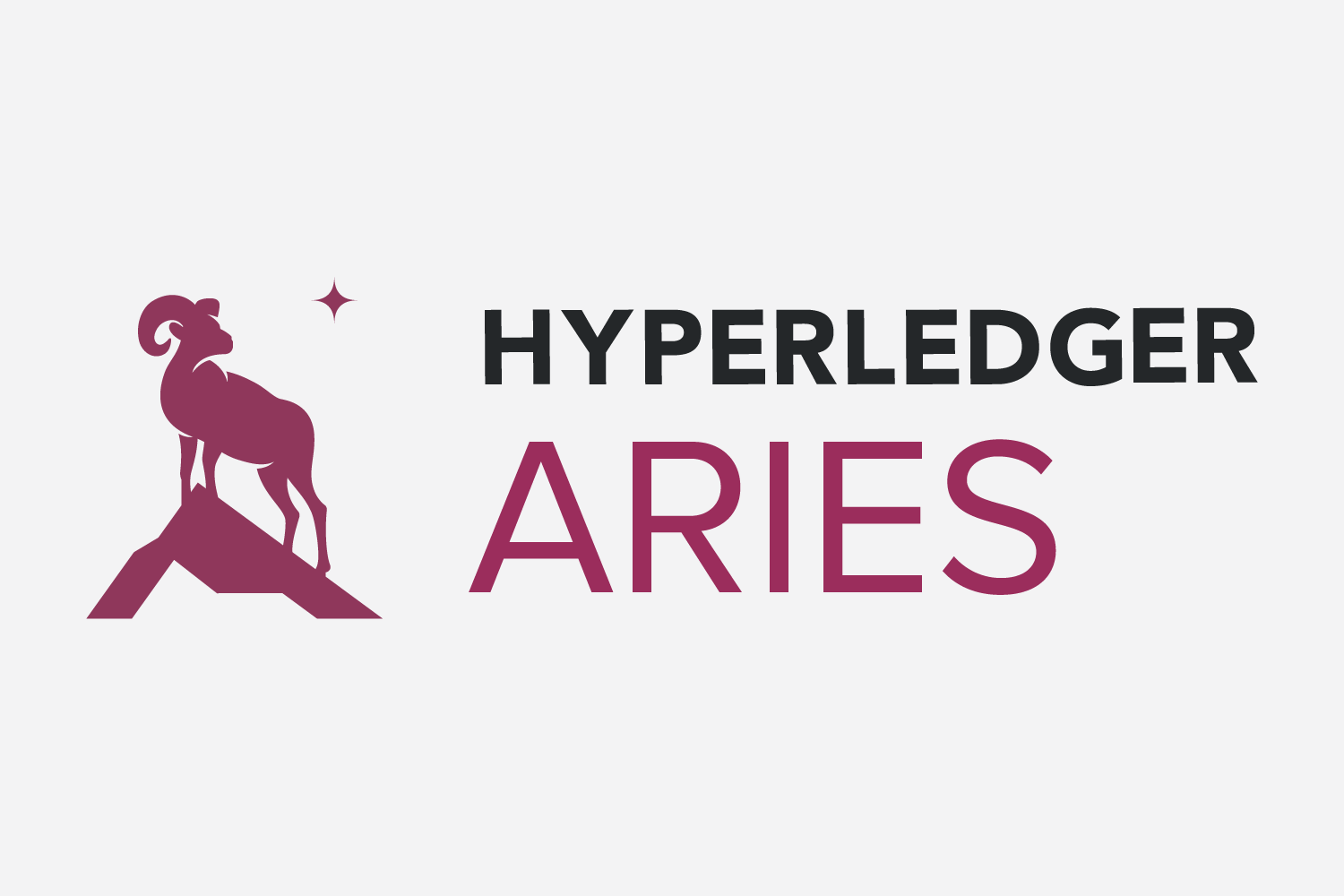
Video: Hyperledger Caliper
Hyperledger Caliper
Currently in incubation, Hyperledger Caliper was initially contributed in 2018 by developers from Huawei, Hyperchain, Oracle, Bitwise, Soramitsu, IBM and the Budapest University of Technology and Economics. It references the definitions, metrics and terminology defined by the Performance and Scalability Working Group. Some of the project’s key characteristics are:
- Unified blockchain benchmark framework
- Commonly accepted definition of performance indicators
- Commonly accepted benchmark cases.
As of June 2019, it supports the following blockchain solutions: Hyperledger Fabric v1.0+ (with the latest verified version being v1.1.0), Hyperledger Sawtooth v1.0+, Hyperledger Iroha v1.0, Hyperledger Burrow v1.0, and Hyperledger Composer.
As far as supported performance indicators go, as of June 2019, we have: success rate, transaction/read throughput, transaction/read latency, resource consumption.

Video: Hyperledger Cello, Hyperledger Composer and Hyperledger Explorer
Hyperledger Cello
Hyperledger Cello is a blockchain module toolkit helping businesses use and manage blockchains in a more efficient way. Particularly for lean businesses and small enterprises, who want to reduce or eliminate the effort required in creating, managing, and terminating blockchains, Hyperledger Cello allows blockchains deployment to the cloud. Operators can create and manage such blockchains through a dashboard, and users (typically, chaincode developers) can obtain a blockchain instance immediately.

Currently in Incubation, “Cello aims to bring the on-demand ‘as-a-service’ deployment model to the blockchain ecosystem”, thus helping in furthering the development and deployment of Hyperledger’s frameworks. Hyperledger Cello was initially contributed by IBM, with sponsors from Soramitsu, Huawei, and Intel (2017).
Application developers and system administrators using Cello can provision and maintain Hyperledger networks. For instance, you can create a group of distributed ledger networks in virtual clouds known as ‘container clusters’, and then, manage and monitor those networks with a configurable dashboard. Additionally, you can build a Blockchain-as-a-Service (BaaS) platform.
Some key features are:
- Deploy, manage and operate blockchains efficiently and automatically
- Support customized blockchain requests (support for Hyperledger Fabric)
- Support various infrastructures (baremetal, VM platforms, container cloud)
- Support advanced operational analytics for system status and ledger behavior
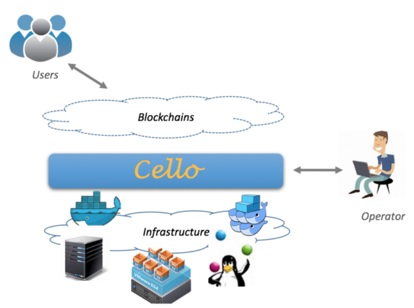
Hyperledger Cello
(Source: https://www.hyperledger.org/blog/2017/01/17/hyperledger-says-hello-to-cello)
Hyperledger Composer
Hyperledger Composer provides a suite of tools for building blockchain business networks. These tools allow you to:
- Model your business blockchain network
- Generate REST APIs for interacting with your blockchain network
- Generate a skeleton Angular application.
Built with Javascript, and leveraging modern tools such as Node.js, npm, CLI, and popular editors, Hyperledger Composer provides an easy-to-use set of components that allows developers to create robust blockchain solutions that drive alignment across business requirements with technical development. Hyperledger Composer supports the Hyperledger Fabric infrastructure and runtime
Currently in Incubation, the project was contributed by Oxchains and IBM in 2017.
Hyperledger Composer has created a modeling language that allows you to define the assets, participants, and transactions that make up your business network using business vocabulary. In addition, the transaction logic is then written by developers using Javascript. This simple interface allows business people and technologists to work together on defining their business network.
The benefits of Hyperledger Composer are:
- Faster creation of blockchain applications, eliminating the massive effort required to build blockchain applications from scratch
- Reduced risk with well-tested, efficient design that aligns understanding across business and technical analysts
- Greater flexibility as the higher-level abstractions make it far simpler to iterate.
As of August 29, 2019, the Hyperledger Composer project is in a deprecated status. What this means is that it is not actively maintained, no new features are developed and no support is provided via GitHub issues. However, if you submit code changes via pull requests, they will be merged.
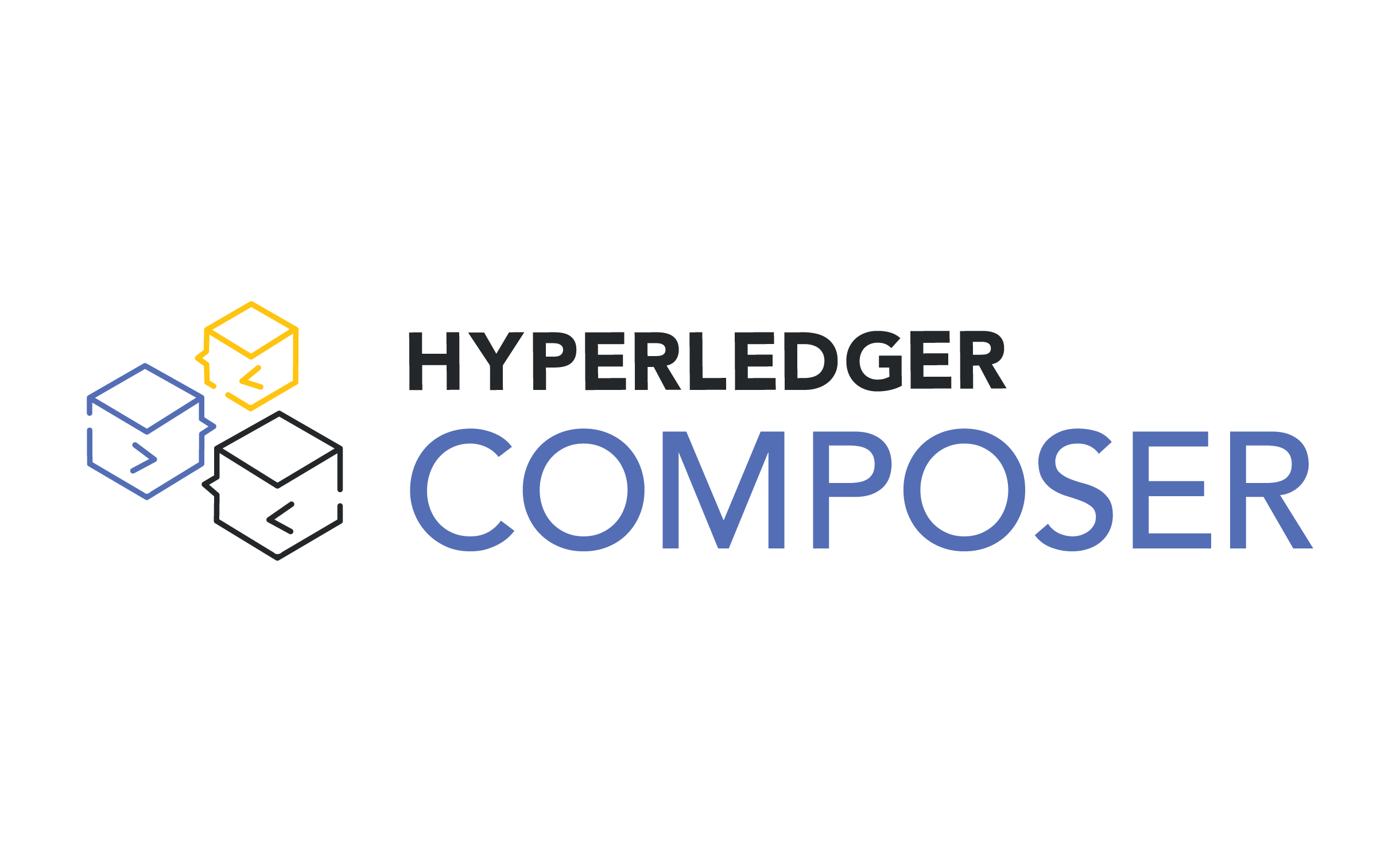
Video: Hyperledger Composer (Simon Stone & Kathryn Harrison)
Hyperledger Explorer
Hyperledger Explorer is a simple, but powerful open source tool for visualizing blockchain operations. It is the first tool to examine permissioned ledgers, allowing anyone to explore the distributed ledger projects being created by Hyperledger’s members from the inside, without compromising their privacy. Currently in Incubation, the project was contributed by DTCC, Intel, and IBM in 2016.
Designed to create a user-friendly web application, Hyperledger Explorer can view, invoke, deploy, or query:
- Blocks
- Transactions and associated data
- Network information (name, status, list of nodes)
- Smart contracts (chain codes and transaction families)
- Other relevant information stored in the ledger.
The ability to visualize data is of critical importance, in order to extract business value from it. Hyperledger Explorer provides this much needed functionality. Key components include a web server, a web UI, web sockets, a database, a security repository, and a blockchain implementation.

Video: Hyperledger Quilt
Hyperledger Quilt
Hyperledger Quilt is an open source business blockchain tool that offers interoperability between ledger systems. It is a Java implementation of the Interledger protocol (ILP) (which is primarily a payments protocol designed to transfer value across distributed ledgers and non-distributed ledgers). Among its key characteristics are:
- Provides a set of rules for enabling ledger interoperability with basic escrow semantics
- Furnishes a standard for ledger-independent address and data packet formats that enable connectors to route payments
- Supplies a framework for designing higher-level use case specific protocols.
Currently in Incubation, Hyperledger Quilt was initially contributed by NTT Data and Ripple in 2017.

Hyperledger Transact
Hyperledger Transact is a transaction execution platform designed to be used as a library or as a component when implementing distributed ledger, including blockchains. Hyperledger framework-level projects and custom distributed ledgers can make use of Transact’s advanced transaction execution and state management to simplify the transaction execution code required within their projects or to gain additional features. Transact provides an extensible approach to implementing new smart contract languages called smart contract engines.
Currently in Incubation, it was originally contributed by Bitwise, Cargill, Intel, IBM and Hacera in 2019. Some of the following features are already supported by Hyperledger Transact, or planned in the short-term:
- Serial and parallel transaction scheduling
- Pluggable state backend
- Transaction receipts
- Events that can be generated by smart contracts
- Support for Sabre and Seth, etc.
Hyperledger Ursa
Hyperledger Ursa is a shared cryptographic library that would enable people and projects to avoid duplicating existing cryptographic work and hopefully increase security in the process. Rather than having each Hyperledger project implement its own cryptographic protocols, it would be more desirable to collaborate on a shared library – this will simplify cross-platform interoperability and increase modularity for distributed ledger platforms.
In the long run, the goal is for Hyperledger Ursa to provide open source blockchain developers with reliable, secure, easy-to-use, and pluggable cryptographic implementations.
The project was proposed by Fujitsu, The Linux Foundation, Sovrin Foundation, Intel, DFINITY, State Street, IBM, Sai Infratel, and Bitwise, and is currently in incubation (since November 2018).

Learning Objectives (Review)
You should now be able to:
- Understand the role of Hyperledger tools.
- Get a high-level understanding of the Hyperledger tools (as of May 2019): Hyperledger Aries, Hyperledger Caliper, Hyperledger Cello, Hyperledger Composer, Hyperledger Explorer, Hyperledger Quilt, Hyperledger Transact, and Hyperledger Ursa.
Conclusions
In this chapter, we briefly explored the tools developed under the Hyperledger greenhouse (as of May 2019), highlighting their key features and use cases.
In the next chapter we will focus on business use cases tackled by Hyperledger technologies.
Chapter 5. The Promise of Business Blockchain Technologies
Video: Introduction (Nathalie Salami)
Learning Objectives
By the end of this chapter, you should be able to:
- Examine several use cases where blockchain technology is actively used to solve real world business problems.
- Discover the factors to look at when evaluating if blockchain technology is right for a particular project.
- Decide when to use and when not to use blockchain technology.
Business Blockchain Technologies Overview
Blockchain is a data structure with an automated way to enforce trust among participants. Consensus algorithms ensure that all participants agree on the data stored within the blockchain. Blockchain opens the door to disrupt any industry that relies on a central authority to confirm authenticity. It also allows independent, and even competing organizations, to share information to gain efficiencies across an industry.
In permissioned blockchains, a consortium of organizations are responsible for authenticating and controlling the participants in a blockchain. In public blockchains, no central authority or administration is required to exchange data. Blockchains can drive business innovation through controlled data-sharing networks for industry consortiums.
The promise of distributed ledger technologies (DLT) to simplify and automate key work functions has many industries taking notice. Businesses recognize the efficiency gains from transitioning from closed and proprietary solutions to standard open source capabilities, such as Hyperledger business blockchain technologies. Several common project features of blockchain applications are taking shape as the technology matures.
How exactly are businesses using these emerging technologies today? Next, we will explore the state of distributed ledger technologies in actual corporate settings, and how they compare against traditional tools.
Video: Hyperledger Advantages for Businesses (Brian Behlendorf)
Business Interest in Hyperledger
When we first launched this course, in 2017, enterprise blockchain technologies were still in the initial stages of their production implementation. The concept of blockchain was at the time mostly associated with bitcoin and cryptocurrency. But the situation has significantly changed in the meantime, and while still considered revolutionary and in early stages, enterprise-grade blockchain technologies are now used in production, changing not only the way we do business, but also the way we envision doing business in the future, as more and more use cases and opportunities are created.
- Smart contracts eliminate the middleman and add accountability (used in various industry sectors, such as real estate, healthcare, government, music, etc.)
- Internet of Things (IoT)-based blockchain applications add a higher level of security, and transparency (in industries like supply chain, healthcare, banking and financial services, automotive, cybersecurity, etc.). Hyperledger Fabric is at the forefront of this revolution.
- Identity security is a key area where enterprise blockchain technologies can make a difference, bringing, for example, a much-needed reduction in identity fraud and theft claims, cutting the red tape of government and local administration bureaucracy, and more. Hyperledger Indy, Hyperledger Fabric, etc. are just a couple of technology examples successfully used in production in this area.
- Blockchain adds data transparency and automation to supply management and logistics, building trust and enabling leaner, more cost-effective processes.
From smart companies, to smart cities, to smart energy management, to streamlining supply chains and financial services, from logistics to digital identities, across both public and private sectors, the opportunities provided by enterprise blockchain technologies are astounding. Talking about blockchain is now in the past; it’s now time to walk the talk! And the sky is the limit it seems!
Video: Blockchain Use Case (Brian Behlendorf)
Hyperledger Blockchains in Production
Over the past few years, there has been a lot of talk about blockchain and its potential in the enterprise landscape. Today, blockchain is no longer a hype: it has become a reality, and is transforming processes and how enterprises do business, across a wide range of industries.
Below is just a small sample of blockchain-based enterprise solution successfully being used in production:
- Supply Chain
IBM Food Trust, powered by Hyperledger Fabric, connects farmers, processors, distributors and retailers to create visibility and accountability in the food supply chain, by making the complete history and location of individual food items (along with accompanying information like certifications, test data, temperature data, etc.) available in seconds once uploaded onto the blockchain.Cambio Coffee, in partnership with ScanTrust, developed a Hyperledger Sawtooth blockchain network to provide transparency and traceability of the coffee journey, from farmers to roasting, to packaging, and shipping. This approach increased customers’ trust in the products and validate their provenance.
- Airline Industry
NIIT Technologies developed a new blockchain application, Chain-m, using Hyperledger Fabric. This new application aims to enhance passenger ticketing processes by adding increased transparency to the process, and improving record-keeping, security and agility, and ultimately, reducing operational costs. - Enterprise Operations Management
JD.com, the largest retailer in China, has developed its own enterprise blockchain platform aimed at streamlining numerous operational procedures, such as tracking and tracing the movement of goods, charity donations, authenticity certification, property assessment, transaction settlements, digital copyrights, etc. JD Blockchain Open Platform uses Hyperledger Fabric. - Insurance Compliance Data
The American Association of Insurance Services has developed openIDL (open Insurance Data Link), a system built on IBM Blockchain, thus powered by Hyperledger Fabric, which is designed to automate insurance regulatory reporting. - Decentralized Identities and Trusted Credentials
In an attempt to streamline their business-oriented services, the government of British Columbia started working on a project based on Hyperledger Indy. OrgBook BC is an online directory that can be used to quickly verify if an organization is legally registered to do business in British Columbia as a corporation. This is just the first step of a larger blockchain-based initiative aimed at streamlining government services.
- Supply Chain
Next, we will dive deeper into some of the industries that are using blockchain-based solutions, as well as specific use cases.
Supply Chain Management (Part I)
Supply chain management is an important piece of enterprise resource planning (ERP). Supply chain management is the oversight of funds, raw materials, components, and finished products, as they move from suppliers, to manufacturers, to wholesalers, to retailers, to consumers. This movement can occur both within one company, or among several companies. As assumptions change over time, the supply chain models can begin to show weak performance metrics. Good supply chain management will keep product quality consistent, and also prevent either understocking or overstocking of inventory.
Stocking the right amount of inventory over time is also known as supply demand synchronization, and is the key component in just-in-time lean manufacturing and distribution. Companies want to ensure that products are available when needed, but overstocking inventory is costly. Companies that overstock perishable goods must discard items. Companies that overstock non-perishable goods cannot use the money paid for those goods for other purposes until the inventory is used. Furthermore, if the price of a good drops while a company is storing excess inventory, then the company will lose money.
Currently, there are weak points in the supply chain management. These weak points occur where there are multiple ERP systems in use across organizations. Data doesn’t flow well through the handshakes or interface points between systems. These weak points usually happen during transference of ownership, or change in status between two parties. Visibility is limited at the hand-off points of funds, raw materials, components, or finished products. This lack of transparency is often intentional, as companies don’t want to expose their competitive advantages (e.g., an inexpensive supplier who delivers quality products on time). Additionally, a company could be cut out of a supply chain if members start transacting directly with that company’s suppliers.
Supply Chain Management (Part II)
Blockchains are being used to solve problems in supply chain management by eliminating the need for a trusted third party to certify raw materials, components, or finished products, as they travel through a supply chain. Every participant, or node, contains a copy of all transactions. This provides an audit trail of every transaction that has occurred in the system. A change would be validated or rejected by the nodes in the system. Because all participants have a copy of all past transactions in the network, any participant can detect if a product is not as advertised. Instead of examining raw materials, components, or finished products at several points in the supply chain, a record of the inspection would be available and bound to the item as it flows through the supply chain. Although a record of the transaction is public and tied to the movement of physical items across the network, specifics such as the quantity of goods, or the identity of the parties transacting, can be done pseudo-anonymously in a blockchain. Such a granular view of movement through supply chains improves resource allocation.
The trade finance industry can also leverage information visible in a supply chain blockchain. In its broadest sense, trade finance manages capital required for international trade. Trade financing has become the norm for cross border transactions, with the World Trade Organization estimating that “up to 80 percent of global trade is supported by some sort of financing or credit insurance” (2016). An exporter needs to mitigate the risk of non-payment, while an importer wants to mitigate the supply risk. The function of trade finance is to act as a third party to remove the payment risk and the supply risk, whilst providing the exporter with accelerated receivables, and the importer with extended credit. Institutions that provide capital during these trades can leverage the information visible in a supply chain blockchain to better evaluate companies for lending.
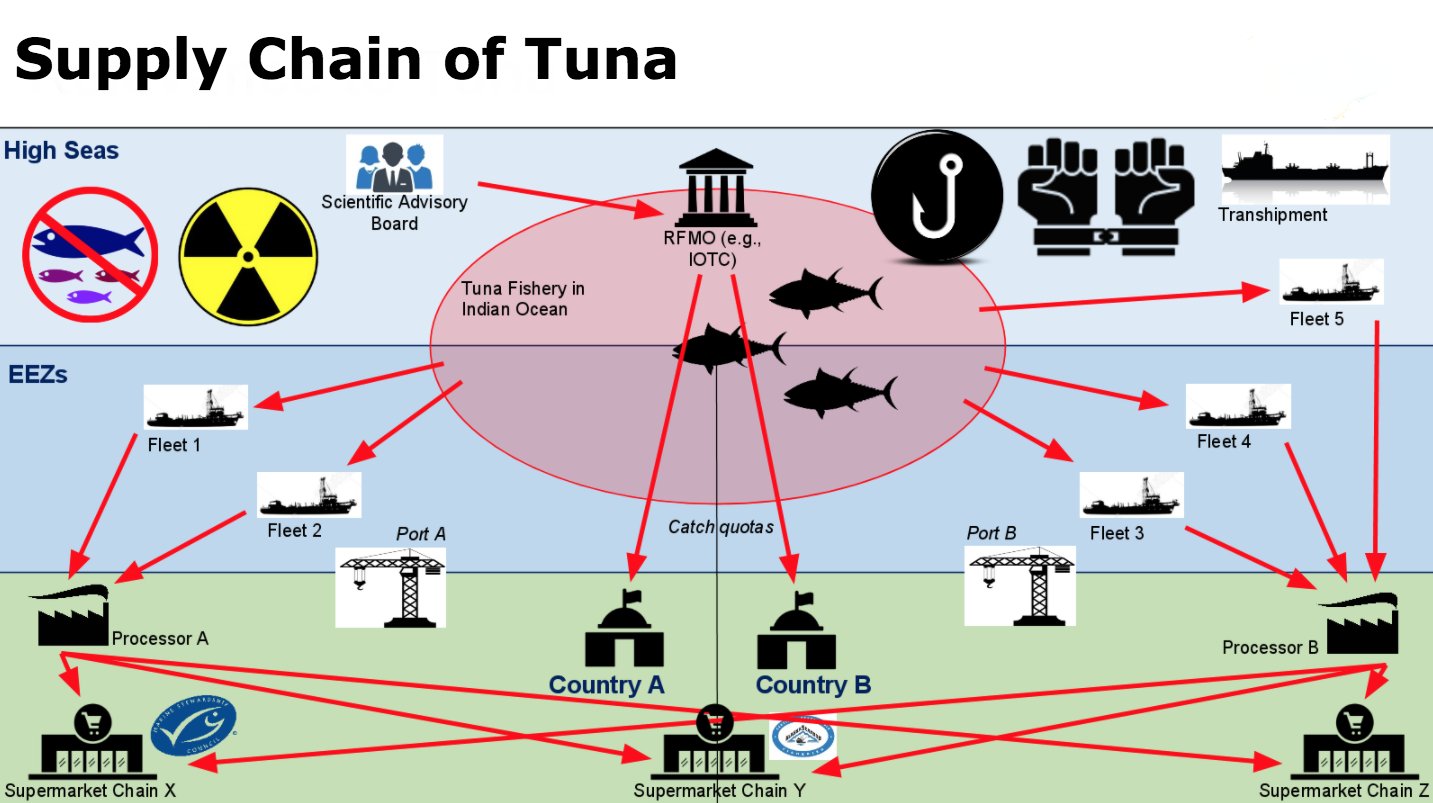
Source: Nishan Degnarain (used with permission)
Supply Chain Case Study: Walmart
As one of the world’s leading businesses in the supply chain industry, Walmart is constantly looking for ways to enhance transparency and traceability in the food system, and over the years has tried numerous solutions and approaches to solve this problem. Then, the hype of blockchain caught their attention. They looked into various blockchain technologies that could potentially be used to create a traceability system for their supply ecosystem, such as Ethereum, Burrow, Hyperledger Fabric, etc.
In partnership with IBM, they decided that Hyperledger Fabric was the best fit for their needs (enterprisegrade, permissioned, open source, vendor neutral, modular, plug-and-play). In October 2016, Walmart and IBM announced the two projects they were focusing on: one on tracing the origin of mangoes sold in US Walmart stores, and the other project was focusing on tracing pork sold in its China stores.
“The Hyperledger Fabric blockchain-based food traceability system built for the two products worked. For pork in China, it allowed uploading certificates of authenticity to the blockchain, bringing more trust to a system where that used to be a serious issue. And for mangoes in the US, the time needed to trace their provenance went from 7 days to… 2.2 seconds!” As a result, Walmart and IBM worked on expanding the system, both within and outside of Walmart; IBM Food Trust, an ecosystem of producers, suppliers, manufacturers, retailers, etc., working together to create a smarter, safer and more sustainable global food system, was born.
Today, Walmart traces over 25 products from five different suppliers using the IBM Blockchain built on top of Hyperledger Fabric: from mangoes, strawberries and leafy greens, to meat and poultry, to dairy and almond milk, and even multi-ingredient products like packaged salads and baby foods. And it plans to expand the use of this system to include more products and categories in the near future.
You can learn more about Walmart’s successful use of blockchain technologies from this article: How Walmart brought unprecedented transparency to the food supply chain with Hyperledger Fabric.
Supply Chain Case Study: ScanTrust
Another great example of how blockchain technologies can be a great solution for transparency and traceability in the supply chain industry is that of Cambio coffee: if you buy a pack of Cambio coffee and scan the label with your smartphone, you will be able to see all the details of the coffee’s journey, from harvest in Peru, to shipment, to roasting in Shanghai, and delivery to your home. Cambio Coffee is a direct trade organic coffee company that prides itself on building a direct link from coffee farmers to consumers, and the immutable records that are stored on the blockchain are proof that they stay true to their mission.
Cambio Coffee worked with ScanTrust to implement a traceability system built on top on Hyperledger Sawtooth. When ScanTrust decided to implement a blockchain solution to enhance trust, transparency and traceability in the supply chain, they wanted a reliable, proven, open source technology, supported by an active community, and they decided that Hyperledger Sawtooth was the best fit for what they needed, as it is also focused on IoT implementations.
“ScanTrust plans to use the Hyperledger Sawtooth-based solution for other projects. Besides enhancing traceability in the supply chain, the team sees other uses for the technology… A brand could create its own token to incentivize consumers to share data; or it could develop ways to allow consumers to tip the farmer who produced their coffee.”
You can learn more about the this use case from the following article: How ScanTrust brought Transparency to the Supply Chain with Hyperledger Sawtooth.
Property Rights (Part I)
The legal industry has begun to examine how blockchain technologies can minimize disputes around property rights. Property rights are a division of law whereby the rights and responsibilities associated with owning an asset are established. Property ownership rights may include the right to use the asset, the right to profit from the asset, the right to exclude others from using the asset, or the right to transfer the asset to others. Property ownership responsibilities may include tax liability for the asset, maintenance and repair costs, or payment for injuries caused by unsafe or defective conditions of the asset.
Ownership for a particular asset may be transferred in whole, or in part. As a result, property rights or obligations attached to a particular asset may belong to several different entities at the same time. For example, if you purchase a plot of land, you have the right to use that land. However, the usage of the land is most likely limited by the government. The right to use the land may be taken away from you by foreclosure if you do not pay property taxes. Similarly, your right to use the land is limited to permitted uses per that areas’ zoning laws. It is unlikely that you will be allowed to operate a pesticide manufacturing plant in the middle of a residential neighborhood. If you lease out the plot of land, your right to use the property is transferred to the tenant, but you are still able to sell the plot of land to another landlord while the lease is active.
Property Rights (Part II)
Companies may use blockchain technologies to record ownership rights and responsibilities. Specifically, governments have put land registry records on blockchain (Laura Shin, forbes.com, 2016). Companies have also put intellectual property registration and ownership on blockchain (poex.io). Intellectual property includes copyright, trademark, and patents. To legally protect ownership rights in these, one registers their production, or invention, or otherwise proves when the work was established, and that they are the origin of the work.
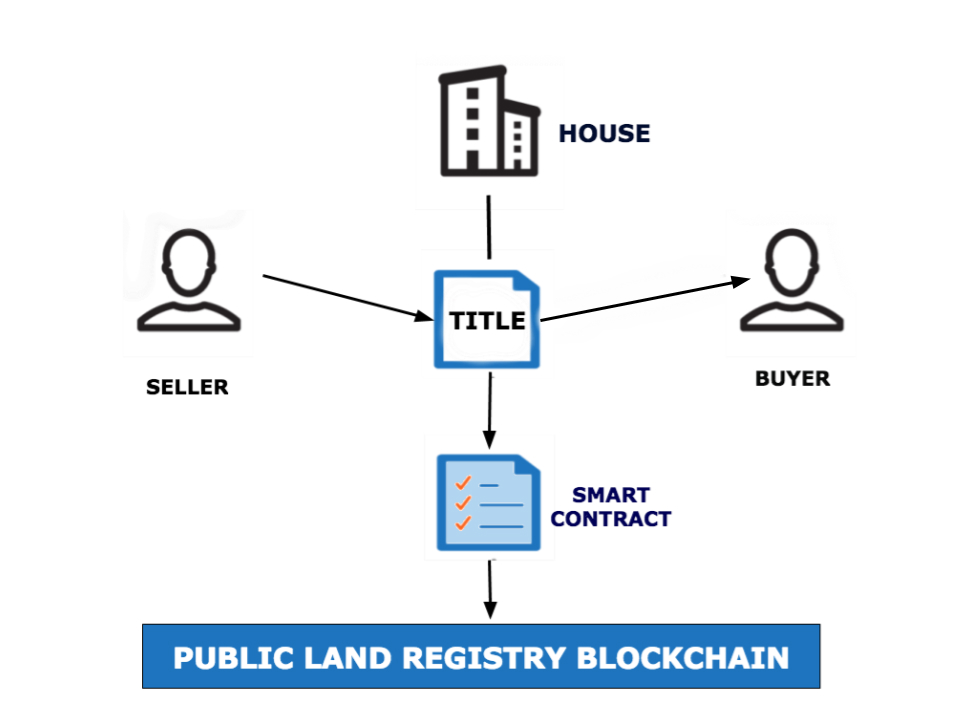
Property Titles on a Blockchain via a Smart Contract
Companies with strong brand value in particular, such as the fashion industry and luxury good providers, are interested in more efficient ways to protect their intellectual property. When data is added to a blockchain, it can provide an immutable, secure, timestamped record for the creation of intellectual property, and any changes to the data can be easily detected. Blockchains establish this in a variety of ways.
A blockchain may record a hash of a document. As an example, photographers could place a hash of their unique digital photographs on the blockchain. The hash of a digital photograph will be constant so long as the photograph file has not been altered. Therefore, the blockchain can control and track the distribution of the photograph, detect the introduction of counterfeit images, and be used to resolve disputes as to who first introduced the image. By placing a hash of intellectual property documents on the blockchain, a party can publicly demonstrate data ownership, and prove the existence of certain documents at a given moment in time, without revealing the actual data. In addition to the hash, you may also choose to store the location of the file in the blockchain, which could be used for retrieval.
Provenance (Part I)
As the previous section on blockchains for supply chain management illustrated, blockchain data improves insight into products, as they move through their lifecycle. Large enterprises are not the only parties to benefit from this increased visibility. Consumers can also benefit from blockchain technology.
Provenance is a record of ownership used as a guide to authenticity or quality. Because of the overhead involved in traditional provenance records, they were only available for very large ticket items, such as works of art. With the efficiencies gained from blockchain technology, provenance records can be available for a wider range of goods. This improved information can aid consumers as they make purchasing decisions.
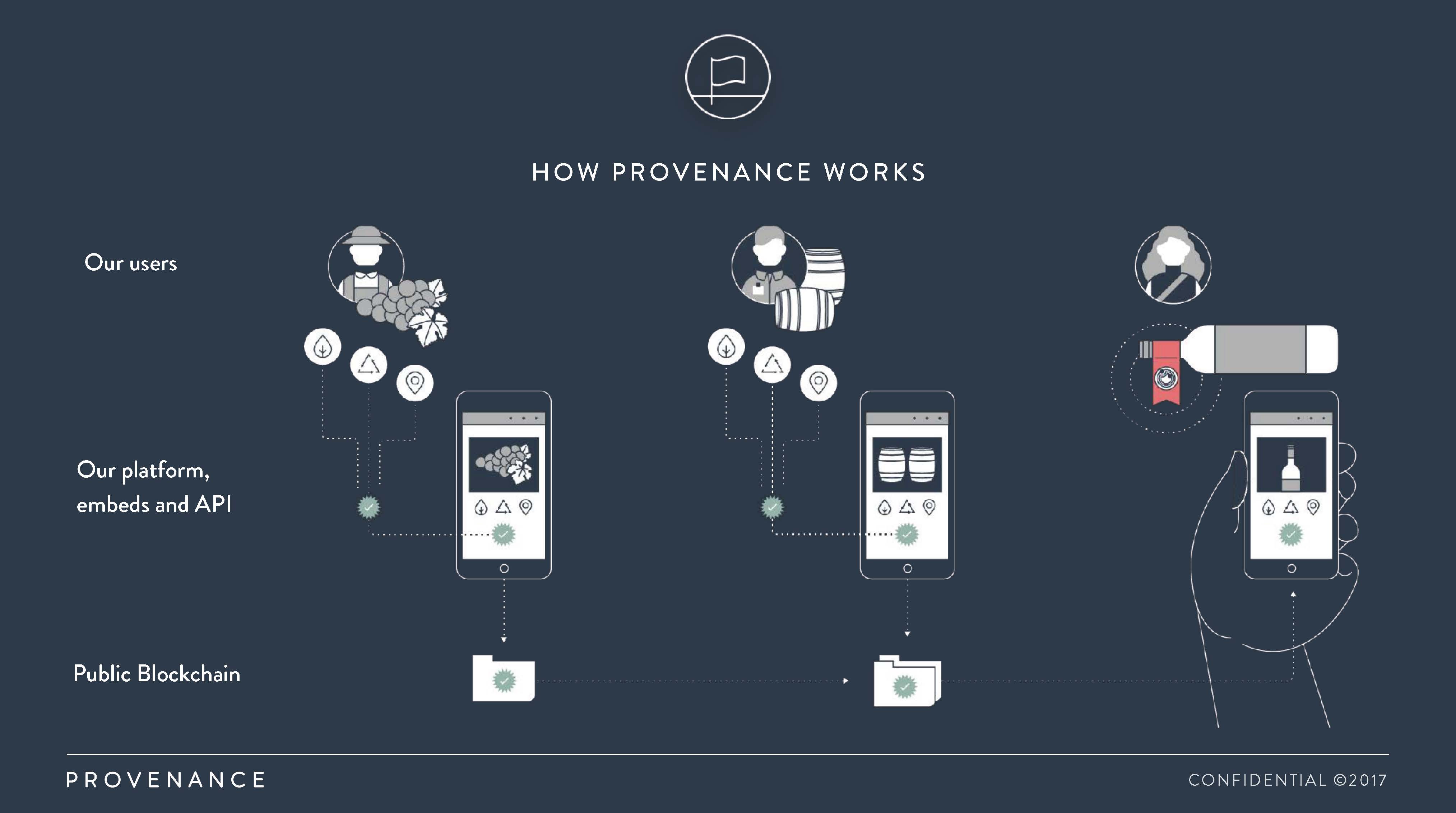
How Provenance Works
(by Project Provenance Ltd, used with permission)
How do you, as a consumer, really know that you purchased an authentic item? Why is authenticity important? Some consumers want to make sure that fair trade and fair labor standards are upheld in the products they purchase. Others want to make sure that none of their products have been tested on animals. Still, others are concerned with the use of harmful chemicals during product manufacturing. Those consumers are willing to pay a premium to make sure that they are not funding operations that are not in line with their values. Counterfeit products, however, take advantage of the higher price point a brand that upholds strict standards can command. Their margins are increased over the authentic brand because they cut corners during production.
It turns out that counterfeit products are a global problem affecting several industries. For example, the European Union Intellectual Property Office (EUIPO), in collaboration with the International Telecommunication Union (ITU), estimates that $48 billion worth of smartphone sales were lost to phoney phones in 2015 (Karen Gilchrist, cnbc.com, 2017). Also, “the Interprofessional Council of Bordeaux Wine estimates that 30,000 bottles of fake imported wine are sold per hour in China”, whereby some estimate half of the wines retailing for more than $35 in China are counterfeit (Pamela Ambler, forbes.com, 2017).
Provenance (Part II)
In order to be certain that your product is authentic, you would need either a record of all the transactions for the life of the item, or a trusted third party. Trusted third parties certify the authenticity or quality of an item. They function as a new data layer between data silos, and increase costs of transactions by charging for providing data and certifying products. Some examples of such trusted third parties are the National Organic Program (USDA Organic) for produce, Fair Trade USA for human worker conditions, or the Gemological Laboratory of America (GLA) for jewelry, diamonds, and gemstones. Blockchains can serve the function of these trusted third parties by uniquely identifying products, and certifying their authenticity. Alternatively, these trusted third parties can leverage blockchains by recording their audits and inspections on blockchains. This would reduce the overhead needed to certify products. For example, a manufacturer could prove that its sources also abide by the certification authorities’ standards if those sources are listed on blockchains as having passed all requirements. The timing of the source’s original certification and renewals could be viewed by any interested party.
As a consumer reading from a blockchain, you would be able to verify a product’s authenticity by seeing the full chain of custody for an item. Hyperledger frameworks allow consumers to view important data attached to the goods, without necessarily viewing exactly who conducted each transfer down the supply chain line. Therefore, the promise is that you will be assured that the product you are purchasing is an authentic product, without necessarily allowing the public to view your purchasing habits, all leveraging distributed ledger technology.
Provenance Use Case: Circulor
For years, consumers have been looking for ethically-sourced products, and a well-known example is that of diamonds provenance. A much less known conflict mineral is tantalum – a rare mineral used to make capacitors found in devices like smartphones and laptops. Rwanda is the world’s largest supplier of tantalum; however, at times, tantalum is also smuggled in from Congo, where children or enslaved workers are used to mine it. As a result, there are many regulations passed by OECD (Organisation for Economic Cooperation and Development), US, and EU (US Dodd-Frank Act of 2010, EU Conflict Minerals law, etc.) aimed at improving traceability. Despite this regulations, there has not been a reliable way to prove the source of tantalum.
Blockchain technologies have been a game changer. Circulor, a UK-based company, has developed a system that traces the origin of tantalum, ensuring it is mined, transported, and processed according to approved regulations. This system is built on Hyperledger Fabric and delivers the first mine-to-manufacturer traceability of tantalum. How were they able to succeed? By creating a very tightly controlled system, that recorded the tantalum journey every step of the way: from mining in Rwanda, to refining in Macedonia, to manufacturing in USA, shipping from USA, final assembly in China, and the distribution to consumers.
The system went smoothly into production in the fall of 2018, and included, to start with, three mines in Rwanda and a refinery in Macedonia. And the plan is to bring more mines into the system. On top of that, Circulor aims to expand the system they built to cover other minerals and countries.
You can read more about tantalum traceability success story on the Hyperledger website: Circulor achieves first-ever mine-to-manufacturer traceability of a conflict mineral with Hyperledger Fabric.
Finance (Part I)
“Blockchain has huge potential to move the financial services industry away from messaged based models, slow reconciliation processes and inefficiency of fragmented data stores. With blockchain, financial services can move to a shared data construct, driving down costs, increasing efficiency and opening up entirely new business models“.
– David Treat, Accenture
The Bitcoin blockchain was created as a “peer-to-peer electronic cash system” (Satoshi Nakamoto, Bitcoin). Therefore, the first blockchain use case in existence was payments. However, Bitcoin proved to be quite slow to process payments, “somewhere in the region of 7 transactions per second“, when compared to Visa, which “averages around 2,000 transactions per second, with peak capacity of perhaps 50,000 transactions per second” (Guy Brandon, due.com, February 2017). Developers are actively working to increase the throughput capacity of Bitcoin and other blockchain payment systems (lightning.network). Payments, especially international payments, can be quite costly. Blockchain technologies plan to decrease the costs associated with payments, by allowing parties to interact directly, instead of transferring through an intermediary, such as a bank. In addition, having a record of all past payments is useful to auditors and regulators. Financial institutions have heavily researched blockchain payment systems because a universally recorded world state of payment information can decrease the number of payment disputes among institutions.
Finance (Part II)
The finance industry, in particular, has shown early interest in blockchain technology. R3, a fintech company that is a member of the Hyperledger consortium, has brought together more than 100 leading financial institutions to examine blockchain technology. The finance industry has already recorded business transaction agreements on blockchain. Currently, bonds, invoice financing, letter of credit transactions, and interest rate swaps governed by an ISDA master agreement have all been recorded on blockchain.
The financial industry would like to improve transaction settlement through blockchain technology by leveraging smart contract functionality for executing trades. Absent blockchain technology, a complex process known as the post-trade cycle is initiated once parties “execute” a trade. The post-trade cycle involves a series of steps to verify the terms of a trade, and to transfer assets involved in the trade in order to effectuate and settle the trade. Some trades are currently required by law to go through a separate central clearing organization. This organization steps in as the counterparty to each trade, creating two distinct contracts for each trade. These organizations are central securities depositories, whose role is to minimize the risk of trade default, and also to enforce rules against overexposure to certain types of trades.
Finance (Part III)
Although every trade has its own lifecycle, generally, the following steps will occur:
- Parties execute a trade. Executing a trade occurs when parties agree on the details of a trade and are willing to enter into the deal.
- One party will draft an inception document, capturing all the terms of the trade, and will send it to the other party to get the trade confirmed.
- The recipient of the inception document will check the details of the trade and confirm the trade by signing and returning the document. Confirmation communication is done often by Fax, SWIFT, or Telex.
- The trade is allocated. For flexibility of profit and loss booking, parties will often allocate the trade to various sub-entities within their organization.
- Each trade will be stored by the party who was allocated the trade on an internal database. For ease of identification, the trade is assigned a unique Trade ID as a standard identifier.
- Post-Trade Changes are sometimes made by the parties. This can occur when:
– The trade can be amended with consent of both parties
– One party may assign its position in the trade to a different party
– A partial termination of the trade may be triggered if a change in the notional of the trade that is not pre-fixed according to the agreement occurs
– Termination of the deal before maturity of the trade may occur, which may entail a termination fee. - Payment is made. These payments may be at the close of a trade, or at intermediate stages while a trade is still open. When the payments are made on an open contract, this is known as ‘revaluation’ and is done to minimize the risk of nonpayment by a counterparty whose position has weakened in the trade due to events that occurred after trade execution.
- Audit of the trade and associated payments is performed by the parties. If a dispute occurs, the parties must communicate and come to a resolution for such discrepancies. This is a manual and costly process.
Finance (Part IV)
Smart contracts may greatly improve the process of post-trade settlement, by reducing disputes and errors. Smart contracts will ensure that final settlement will happen when the execution of a trade occurs. With smart contract technology, a legal agreement can automatically execute clauses within it.

The image above shows the automation of back-office processes involved in trade confirmation and post-trade settlement via DLT. An asset ledger stores ownership and transactions. Smart contracts allow the asset ledger to handle collateral management and initiate payments per contract terms. Venues (e.g. exchanges, MTFs, bilateral voice conversations) still match trade requests with a counterparty, and provide price discovery. Querying information on the asset ledger may assist with price discovery. The asset ledger verifies the parties and asset ownership. It will then either accept, or reject the trade. If, for example, the seller does not own the asset in question, or the new trade would result in an illegal overexposure on the buyer side, the trade would be rejected. When a trade is valid and accepted onto the blockchain, the blockchain automates an immediate change in ownership, or a delayed, or contingent asset transfer. The changes in asset ownership or contract terms are securely recorded onto the asset ledger. The contract is programmed to execute automatically, exchanging payments and other assets per the terms agreed to by the parties.
It is still unclear whether courts will enforce blockchain contracts in the same way that they enforce traditional written contracts, with inked paper signatures. Therefore, the current best practice is to record trades on blockchain, alongside traditional legal documentation. The operative clauses in the traditional written contract are converted into smart contract templates to be placed on blockchain once a trade is confirmed. For example, a full ISDA master agreement document would be stored on blockchain, and tied to the smart contract governing the underlying swap or derivative trade. This leverages the predictable outcomes of a legal contract with the efficiencies that can be gained from distributed ledger technologies .
Finance (Part V)
There are both advantages and disadvantages to controlling funds on blockchain. If funds aren’t under the control of the smart contract, then there is no way a payment can be guaranteed. If funds are controlled by the parties’ smart contract agreement, then those payments can indeed be guaranteed at the close of the trade. However, this also means that those funds cannot be used by the parties’ for anything else throughout the lifecycle of the smart contract. Today, a party may use the funds separate from the contract. This exposes the other party to the risk of nonpayment, but frees up capital for other purposes. The connection between risk and return is not a problem that blockchains can solve.
Conducting post-trade settlement in an automated way through smart contracts promises to introduce efficiencies, and reduce friction associated with trades. However, the industry has experienced some barriers to the adoption of blockchain technologies. Primarily, data privacy rules have come into conflict with the way standard blockchain protocols operate. Some regulations in the finance industry will not allow you to share information, or store it on a shared medium, even if it is encrypted. In addition, regulations covering securities professionals specify how ownership of certain assets must be recorded and properly transferred. Securities professionals include broker-dealers and investment advisers. These rules were written without the anticipation of blockchain technologies, and are at odds with the fully digital transference of assets over blockchain technologies. Either these regulations will need to adapt to blockchain technologies, or blockchain technologies will need to introduce new features conforming to existing regulations. The adoption of blockchain technologies for post-trade settlement will likely change the role of governments in the financial oversight. There will be less of a need to enforce individual trades and resolve settlement disputes, but the government may collect better data on existing trades by viewing and querying the blockchain. With this increased insight into the market, the government may or may not develop stronger standards for trades through smart contracts.
Healthcare (Part I)
A number of multi-party processes in the healthcare industry can leverage distributed ledger technology. By streamlining these multi-party processes, the healthcare industry can reduce the time and expense of collecting and verifying multiple pieces of information in order to deliver quality care to patients. Healthcare providers and insurance companies have begun to explore how blockchain can improve the delivery of patient care.
In 2015, the US spent 27.42% of the federal budget, or $1.05 trillion, on healthcare (National Priorities Project). Because these costs are so high, the US government, in particular, has invested resources into healthcare blockchain technology. The Office of National Coordinator for Health Information Technology (ONC) is responsible for health information technology. It has recognized a need for nationwide interoperability and standards for electronic health records, claims processing, and verification of provider credentials. To that end, it has sponsored many government blockchain initiatives in healthcare.
The healthcare industry has already placed medical insurance enrollment information on blockchain for verification, and plans to incorporate many other aspects of medical insurance claims processing on blockchain. One cost borne by health insurance providers is auditing care providers. Health insurance providers must verify whether a practitioner actually delivered the care that he or she was obliged to deliver to the patient. Health insurance providers must also audit the financial aspects incurred as part of this care, to ensure that care was paid, and the charges were accurate. Tying the care auditability with the payment auditability provides a key advantage to reducing the potential for fraud.
Healthcare (Part II)
The healthcare industry has examined placing prescription drug fulfillment processes on blockchain since they involve gathering and checking information from many sources. Insurance benefits investigation eligibility checks are performed to see if insurance will pay. Prior authorization and step therapy requirements are checked to see if a patient is able to receive a particular drug, or if other drugs are preferred. Formulary checks, patients’ assistance checks, and pharmacy stock checks must all be performed. The healthcare industry has also used DLT to handle online identity management, by uploading verified pieces of a healthcare professional’s credentials for license verification.
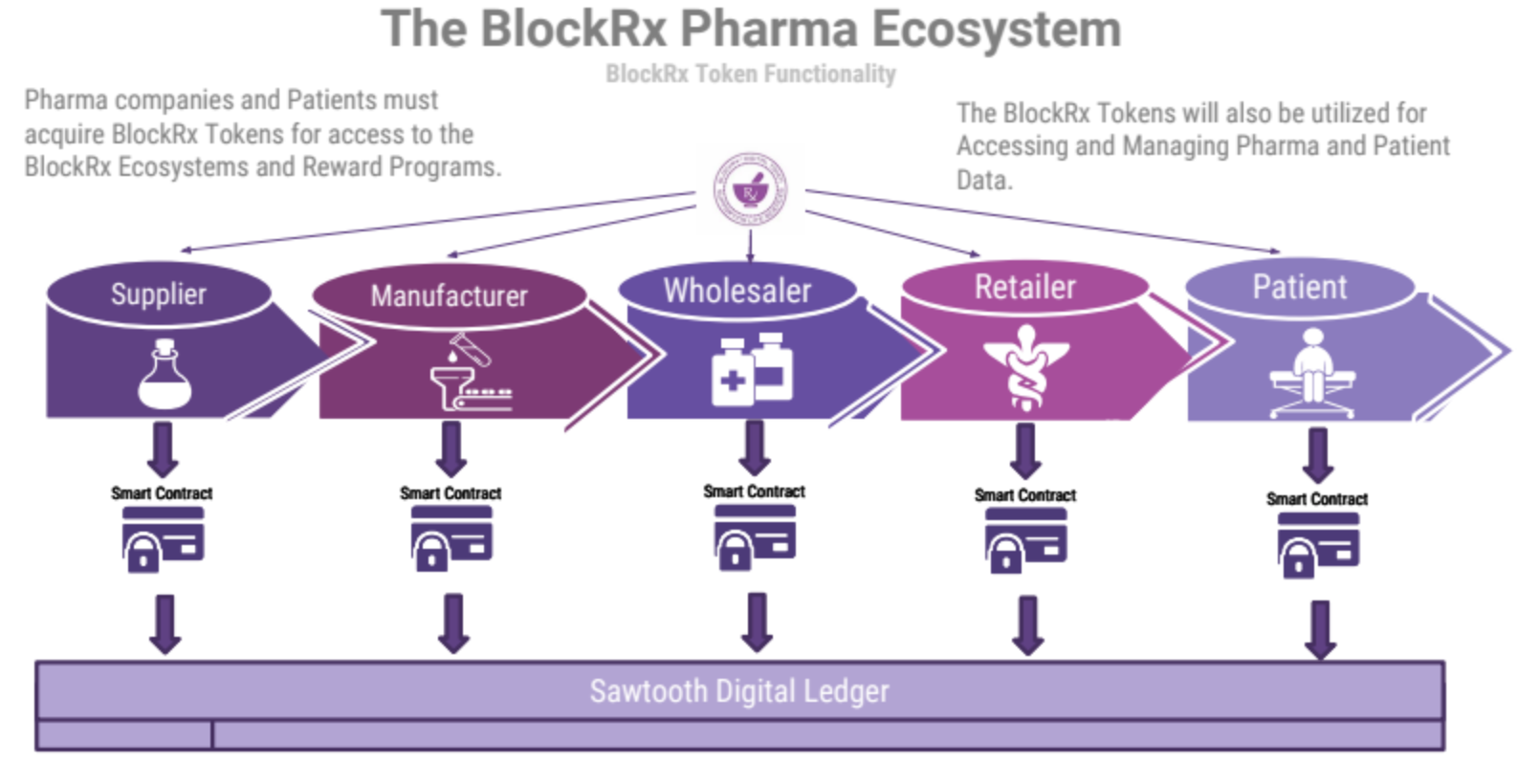
By The BlockRx Project, retrieved from the Hyperledger Healthcare Working Group, August 22nd, 2017 Meeting
Another area blockchain is used in healthcare is to protect data from cybercrime. Data breaches happen on a daily basis across all industries, and healthcare is no different. In fact, 1 in 4 data breaches occur in the healthcare sector, affecting millions of people: more exactly, 1 in 13 patients in the U.S. are affected by breaches. Why is healthcare data so sought after by hackers? Because it’s personal, permanent and detailed: from social security numbers, to address, to family history, to confidential medical history.
Education
Blockchain solutions are being successfully implemented across various industries. As the technologies advance, more and more potential use cases arise. Education is one such area that could stand to benefit from distributed ledger technologies:
- Streamlining verification procedures for academic credentials, thus reducing fraudulent claims and bringing more transparency, ease of use, and speed to this process.
- Verifying e-portfolios of digital badges
- Securing and sharing student records
- Identity management
- Sharing security data (from security cameras and sensors, for example) across device networks
- Creating learning marketplaces
- Records management
- Increasing accountability and transparency for charitable school donations
- Streamlining the public assistance system for families and students.
You can learn more about the potential advantages of using blockchain solutions for education from the following article: 20 Ways Blockchain Will Transform (Okay, May Improve) Education.
Education Case Study: Sony Global Education
We’ve all experienced the process of enrolling in higher education or applying for a skilled job – no two applications are the same, as each institution uses their own individual application and validation processes. Similarly, the credentials we must have when applying each require different validation process as well. Needless to say, this is a rather long and complicated process. Sony Global Education has identified in Japan the need to create a comprehensive, open and trusted system to record educational and training credentials of Japanese citizens. But this need is not limited to Japan alone – it spans worldwide. As such, Sony Global Education aims to create a system that will store this siloed data into one system, gathering people’s academic and training credentials and then controlling access to this recorded data.
Sony Global Education decided to use Hyperledger Fabric, as it is a trusted, secure, open source, platform. The solution they designed was already tested successfully. Moreover, Sony Global Education is working with the Japanese Ministry of Internal Affairs and Communications to develop a next-generation system for managing digital transcripts based on their tested solution, aiming to secure the authenticity of transcripts and allow them to be safely shared within a trusted network.
You can learn more about this use case reading Sony Global Education Chooses Hyperledger Fabric for a Next-Generation Credentials Platform.
Smart Energy Management
We live in an increasingly connected and energy-dependent world. Balance between supply and demand is imperative to ensure electricity demand is met. However, the increasing demand in electricity adds increased pressure on conventional energy sources. For the most part, the existing electricity grid is coping with the existing demand; however, when unexpected events occur (weather-related, for example), the pressure exerted on this grid can reach dangerous, unsustainable levels. And with the advent of increased dependency on electricity in day-to-day life, time will come when conventional resources will no longer be sufficient. Drastic times require out-of-the-box solutions.
Enterprise-grade blockchain technologies are playing an increasingly important and innovative role in an increasing number of industry sectors, including the energy sector. In 2017, IBM partnered with TenneT, sonnen and Vandebron to develop a distributed database for managing the electricity grid in the Netherlands and Germany:
- TenneT is focusing on finding new sustainable ways to cope with the increasing dependency on and demand for electricity. In their quest to maintain the supply-demand balance, TenneT is exploring the use of a Hyperledger Fabric-based permissioned blockchain network that will integrate renewable electricity sources (such as electric cars and household batteries) in the energy grid.
- TenneT and Vandebron are running a pilot project in the Netherlands to test this potential solution. “Vandebron will work with customers who own an electric vehicle to make the capacity of their car batteries available to help TenneT balance the grid. Vandebron will provide this service to its customers without compromising the availability of their car battery. The blockchain enables each car to participate by recording their availability and their action in response to signals from TenneT.”
- TenneT and sonnen are running another pilot project in Germany, focusing on re-dispatch efforts to prevent regional overloads on the energy grid by integrating renewable energy sources into the electricity supply network. In Germany, this would be needed, for example, when wind energy produced in northern Germany cannot be transported to industrial centers in the southern part of the country. To solve this issue, a network of residential solar batteries aims to reduce the pressure of the distribution limitations. The blockchain network will allow the TenneT operator to see available, ready-to-activate residential solar batteries, and then record the batteries’ input to the electricity grid.
If tests are successful, this Hyperledger Fabric-based implementation could then be implemented worldwide, adding much needed flexibility and security in the energy management system.
Smart Cities Use Case: Smart Dubai
Dubai is known for being a world-class business, cultural, and touristic destination. Dubai aims to become the world’s first government fully powered by blockchain technologies by 2020. Smart Dubai is a city-wide effort to empower residents and visitors alike via digital transformation, an effort that relies on the partnership between the private sector and government entities. It aims “to make Dubai the happiest city on earth through technology innovation” by creating an efficient, blockchain-based city government, digitizing all of its services to add increased transparency, security, efficiency and reduce bureaucracy. Below we highlight just a few of the Smart Dubai initiatives:
- The Dubai Blockchain Strategy aims to enable the execution of all applicable government transactions through blockchain by 2020.
- The Decentralized Data Marketplace leverages blockchain technology to ensure the security and immutability of transactions, tokenization to hide sensitive information, etc.
- The UAEPASS is the national digital identity platform, giving UAE citizens, residents and visitors access to local and federal government services, as well as those of private companies, all on a single smart application, allowing them to authenticate and sign documents digitally.
- The DubaiNow mobile application is a one-stop shop for smart services, unifying more than 55 key services from 22 government agencies. This application allows users to manage their bills, register their cars, renew licenses, track visa applications, obtain general information in real-time (from weather, to public transport, to health, etc.), and much more. This application also enables the Dubai government to implement various social responsibility-related activities: donations are collected and then distributed to a variety of beneficiaries, in collaboration with charities and government agencies. It also allows you to direct how money collected from fines you pay (e.g. traffic fines) are used, among other things.
- Paperless government by 2020 is another goal of the Smart Dubai initiative, allowing officials and citizens to save time and resources, and protect the environment as well. “Adopting Blockchain technology Dubai stands to unlock 5.5 billion dirhams in savings annually in document processing alone – equal to the one Burj Khalifa’s worth of value every year.”
Smart Dubai is embracing a multi-blockchain business model to deliver services, such as IBM’s Hyperledger Fabric-based and ConsenSys’ private blockchain implementation based on Ethereum. In October 2018, Smart Dubai and IBM launched the Dubai Blockchain Platform, the first government-endorsed blockchain-as-a-service platform in the UAE.
Through its ground-breaking, innovative initiatives and forward thinking, Dubai is transforming the life of its residents and visitors alike, creating a high benchmark for other cities looking to leverage innovation and state-of-the-art technologies. And while Dubai has achieved great successes in the past few years, their mission will not stop in 2021. They already have a vision toward Dubai 2050.
“Smart technology has firmly established itself as the engine driving the cities of the future, transforming human communities and activities – from the most mundane of tasks to the most complex. We are constantly on the lookout for new opportunities to meet representatives from other like-minded organisations who share our vision for a smart, connected future that allows people to enjoy seamless city experiences.” (Khaleej Times)
– Dr. Aisha Bint Butti Bin Bishr, Director General of the Smart Dubai Office
Blockchain Best Practices for Enterprises
The use of distributed ledger technologies in production across various industries continues to expand and reach new horizons, as businesses explore new ways to incorporate blockchain in their day-to-day activities. However, in order to increase the success of blockchain business applications, some best practices must be considered:
- Security for the long term
While blockchain transactions are secure and cryptographically protected when it comes to the current technological advancements, we should always keep in mind that nothing is static, and technology continues to advance at an incredibly fast pace. What is secure today may not be so in the near future. Hackers and other bad actors are constantly focusing on breaking the cryptographic algorithms that protect blockchain data today.
To avoid the potential security disruptions of tomorrow, a critical best practice is that users should never put personally identifiable information, or PII, on their blockchains. - File storage on the blockchain
Due to the way blockchains work to store data, replicating it on every other node or peer in the network, storage and compute costs can be incredibly high. To avoid added storage costs, it is recommended that other storage and replication methods to be used – this includes cloud networks like AWS S3, GCP Filestore, etc. This way, nodes and peers can have pointers or links to the data files kept outside of the blockchain network, instead of the actual data. - Permissioned blockchain for private data
On public blockchains, anybody has access to the information stored on the network: they can add transactions and read the data that is in it. When it comes to permissioned blockchains, data can be stored, accessed and used only between partners that have access to it. Permissioned blockchains, such as the Hyperledger technologies, are a great solution for businesses, as they want their data to remain private. Blockchain governance structure
Most blockchain-related challenges are related to the governance model that is chosen. To keep things straightforward, you should define the governance structure upfront very early in the process, even before diving into blockchain: decide how new users/organizations are added to a blockchain network, how to determine if a user/organization should be removed from the blockchain network, include a mechanism that deals with and removes bad actors previously allowed in the network, etc. Keep in mind that things change over time, and as such, the governance procedures may change as well.- Performance and scalability requirements
Blockchain architects must have a clear understanding of the requirements for their specific use cases, and they must ensure that their blockchains meet those requirements. Based on these requirements, decisions must be made early on with each deployment and use case in regards to what technologies to use. - Goals of blockchain business cases
Not every project or solution is successful, unless it is carefully planned, designed and implemented. A carefully thought out strategy must be designed and implemented for each project, to ensure that goals are achieved.
- Security for the long term
Blockchain can be a great solution for numerous business use cases that rely on security, controlled access, accountability, transparency, and efficiency, spanning a wide range of industries, from finance to banking, supply chains, manufacturing, healthcare, telecom, etc. Having well laid plans, goals and best practices can all help enterprise IT leaders explore the growing blockchain ecosystem as they work to capture its strengths for their businesses.
The Outlook of Blockchain for Business
The 2019 Technology Industry Innovation conducted by KPMG around the adoption of blockchain technologies suggests that 41 percent of businesses are likely to adopt and implement blockchain into their business operations in the next three years. Another important aspect revealed by this survey is that 48 percent of enterprises believe that blockchain will change the way they conduct and manage their business activities in the near future.
What areas are expecting significant disruptions due to increased adoption of blockchain technologies? The survey shows that IoT processes are expected to be impacted the most (27%), followed by processes involved in trading (22%), reduced cybersecurity risk (20%), contracts (18%), etc. Industries that are believed to see the greatest blockchain adoption in the near future are financial services, industrial manufacturing and telecommunications.
What advantages would businesses have by adopting blockchain technologies? The KPMG survey outlines some of them:
- Improved business efficiencies
- Product/service differentiation
- Increased profitability
- Cost reductions
- New business insights from incremental data, etc.
Blockchain is viewed as one of the top 10 technologies that will transform businesses over the next three years, and beyond. The 2019 KPMG survey ranked blockchain at number 4, compared to 7 just a year ago. And, according to the Worldwide Semiannual Blockchain Spending Guide (March 2019) from International Data Corporation (IDC), worldwide spending on blockchain-related solutions is expected to reach $2.9 billion in 2019 (an increase of over 88% from the previous year), and $12.4 billion by 2022.
Want to be at the forefront of the blockchain technological innovation? Start assessing your needs to see if blockchain would be a good solution for your business.
Video: What Enterprises Look for When Evaluating Whether or Not to Use Hyperledger (Brian Behlendorf)
When to Use Blockchain
There are certain factors to consider when evaluating blockchain distributed ledger technology for your business. How many participants are in your system? What is the geographical distribution of the participants? What sort of performance requirements do you have? Defining the rules, risks, and responsibilities of each party in your blockchain system is useful as you consider transferring a database to a decentralized environment such as one of the Hyperledger frameworks. Blockchain is best suited for business applications where one or more of the following conditions apply:
- There is a need for a shared common database
- The parties involved with the process have conflicting incentives, or do not have trust among participants
- There are multiple parties involved or writers to a database
- There are currently trusted third parties involved in the process that facilitate interactions between multiple parties who must trust the third party. This could include escrow services, data feed providers, licensing authorities, or a notary public
- Cryptography is currently being used or should be used. Cryptography facilitates data confidentiality, data integrity, authentication, and non-repudiation
- Data for a business process is being entered into many different databases along the lifecycle of the process. It is important that this data is consistent across all entities, and/or digitization of such a process is desired
- There are uniform rules governing participants in the system
- Decision making of the parties is transparent, rather than confidential
- There is a need for an objective, immutable history or log of facts for parties’ reference
- Transaction frequency does not exceed 10,000 transactions per second.
When Not to Use Blockchain
Blockchain technology is a powerful tool, but it is not always the right tool for the job at hand. If you are contemplating using blockchain technology, be sure to evaluate the problem fully. The following conditions are not currently well suited to blockchain-based solutions:
- The process involves confidential data
- The process stores a lot of static data, or the data is quite large
- Rules of transactions change frequently
- The use of external services to gather/store data.
Next, we will discuss in more detail the conditions that are not well suited to blockchain-based solutions.
I. The Process Involves Confidential Data
The biggest advantage and challenge in deploying blockchains is the radical transparency which they provide. Methods are being developed to hide confidential data on the blockchain, while sharing it only to relevant parties. Regulations for data privacy often do not allow for blockchain solutions. A thorough review of the relevant privacy rules governing your business case should be examined to see whether blockchain is appropriate. For example, is leaking data in encrypted form allowed? What level of encryption is required when transmitting data?
II. The Process Stores a Lot of Static Data/Data Is Quite Large
With blockchain technology, the entire database is stored across many nodes in a blockchain system. Because the replication factor of these systems is so high, they are best suited to databases that have many state changes, or store only the minimum necessary amount of information. If the data is relatively static, or if the files to be stored are quite large, a different technical solution may be more appropriate.
III. Rules of Transactions Change Frequently
If the rules around how your business processes are conducted change frequently, or change in unexpected ways, then blockchain may not be well suited for your use case. The rules of transactions in blockchain are often pre-set, and smart contracts do not change execution paths once they have been initiated. Everything that takes place on a blockchain must be completely deterministic. Additionally, blockchains are append-only databases. A relational database may be more suitable if you need to make many changes to your data as the rules of your transactions change.
IV. The Use of External Services to Gather/Store Data
A blockchain smart contract does not currently initiate the retrieval of external data. Instead, one or more trusted parties (“oracles”) must create a transaction which embeds that data in the chain. This data is often gathered and stored in a traditional database by the oracle. Any interaction between a blockchain and the outside world is restricted to regular database operations.
In other words, an oracle pushes data onto the blockchain, rather than a smart contract pulling it in. Once the oracle pushes the data, every node will have an identical copy of this data. This allows for the data to be safely used in a smart contract computation. While oracles allow for blockchain interface with external data, they undermine the goal of a decentralized system. Examine when such a trusted authority should be retained. When the trusted authority would or should be retained, efficiencies in the blockchain are not as high as in other applications.
V. Simpler Alternatives
For some applications, other options are simply more efficient. When evaluating blockchain technology, consider whether regular file storage, a centralized database, or database replication with master/slave relationship between the original and copies is suitable. If those structures are suitable, then you can deploy your application with reduced complexity. Do you need a smart contract or are stored procedures written in an extension of SQL sufficient? Similarly, some applications can simply utilize cryptographic methods common in blockchains, without the database replication mechanisms of a blockchain.
Blockchain Decision Path
The following diagram provides generalized, high-level decision points about when to use or not to use blockchain technology for your business.
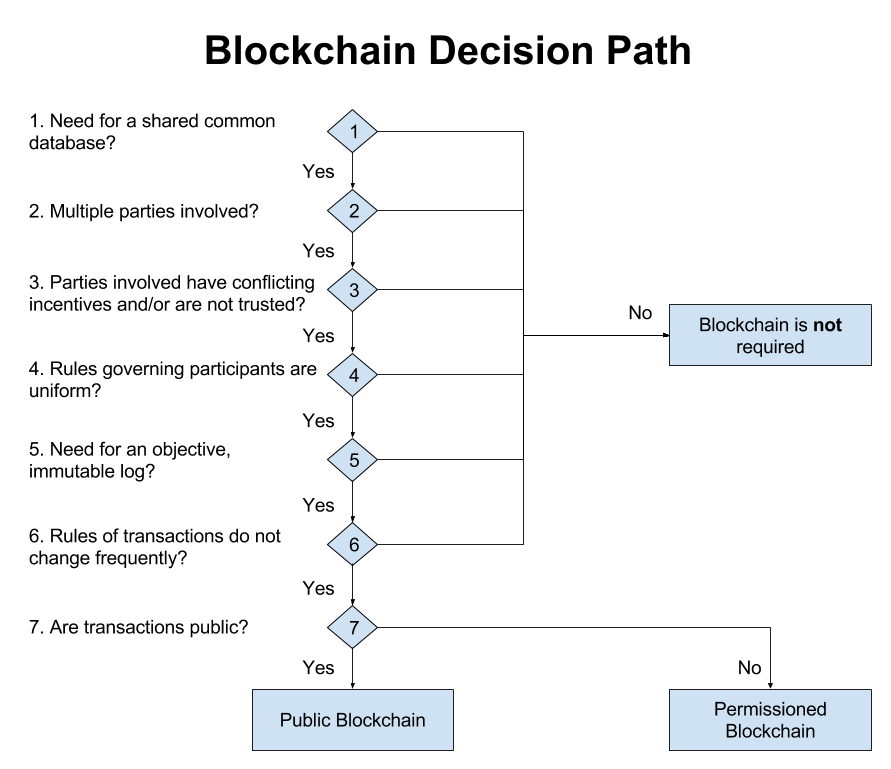
Learning Objectives (Review)
You should now be able to:
- Examine several use cases where blockchain technology is actively used to solve real world business problems.
- Discover the factors to look at when evaluating if blockchain technology is right for a particular project.
- Decide when to use and when not to use blockchain technology.
Conclusions
A number of business problems are being tackled with blockchain technology. It will be interesting to see what emerges as Hyperledger continues to develop DLT and the tooling around it. By examining the factors outlined in this chapter, you can evaluate the use of blockchain technology for your particular project.
Chapter 6. What’s Next?
Hyperledger Community
The development of the Hyperledger projects is led by a diverse group of technical, open source contributors. We are always looking for help to build an open source ecosystem of business blockchain technologies. If you are interested in contributing to and learning from the community, we welcome you to join the Hyperledger effort.
Joining the Hyperledger Community
You too can join the Hyperledger Community:
- For developers
Read the Hyperledger code on GitHub. Join the Hyperledger discussion at Rocket.Chat. Search for open bugs, or report a new one in the Hyperledger’s bug database. - For business leaders
For key updates from Hyperledger, join the mailing list. Explore all Hyperledger business solutions. - For educators and community leaders
You can start or join a Hyperledger meetup. Development updates from Wiki can be found here.
- For developers
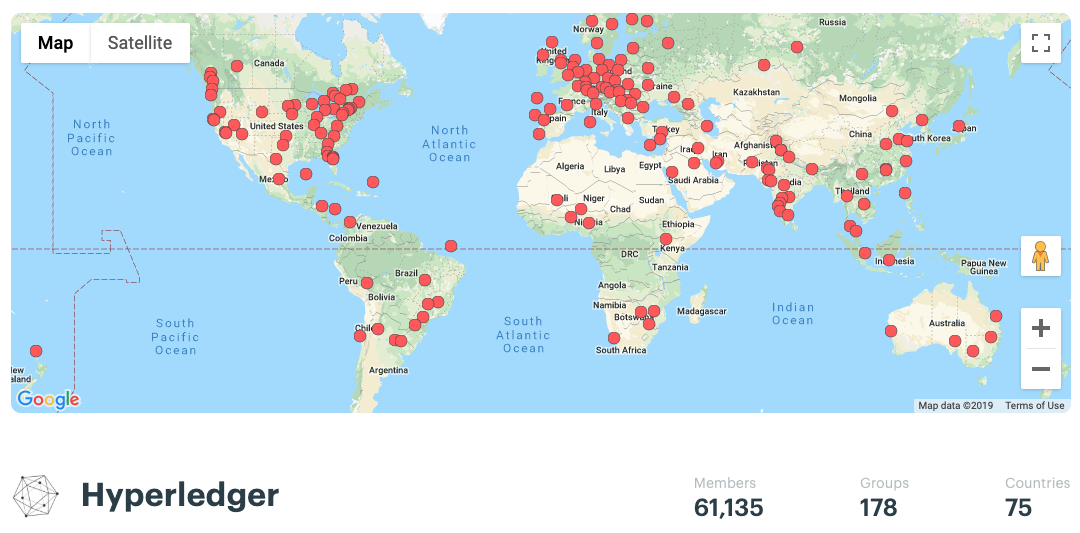
Hyperledger Global Meetups (as of 06/24/2019)
Hyperledger Working Groups
The Hyperledger Community’s working groups are open to the public. Developers and tech leaders can engage with any of the Hyperledger’s open community channels at this page.
Below, you can see an overview of Hyperledger’s working groups:
- Architecture Working Group (AWG)
This is a technical workgroup focused on developing an architectural framework for Enterprise class distributed ledgers, towards convergence on a modular architecture. - Identity Working Group
This group discusses, researches, and documents ways to capture, store, transmit and use identities on DLT, with a focus on projects under the Hyperledger umbrella. - Learning Materials Development Working Group
This group is focused on developing open source training material to educate people on Hyperledger and its projects. - Performance and Scale Working Group
This group discusses, researches, and identifies key metrics that relate to the performance and scalability of a blockchain and blockchain related technologies. - Smart Contracts Working Group
This group focuses on giving an academic perspective to this research topic and also on practical ways to utilize them on different DLTs that are under the Hyperledger umbrella, and explores all potentials from deploying them in everyday software solution scenarios. - Technical Working Group China
This group acts as a bridge between the global Hyperledger community and the emerging technical user and contributor community in China.
- Architecture Working Group (AWG)
Learning Materials Development Working Group
The Hyperledger Learning Materials Development Working Group is focused on developing training materials that aims to expand people’s knowledge of Hyperledger and its projects. Members of this group collaborate with other Hyperledger working groups, Hyperledger team members, project maintainers, and volunteers from all over the world to identify training needs, identify strategies and solution to address those needs, and develop training material that targets both technical and non-technical audiences.
Among other things, members of this working group support the development of this MOOC by reviewing existing content and contributing new material, suggesting improvements, as well as providing assistance in the course forum when needed.
If you would like to contribute to Hyperledger projects, you don’t have to be a technical guru to do so. There are many ways to help, and working on developing training materials is one of them. Anyone is welcome to join this group to learn more about how to get involved.
Hyperledger Special Interest Groups (SIGs)
There are also a number of Special Interest Groups in the Hyperledger Community, focused on specific industries. You can learn more about these groups and their focus:
- Healthcare SIG (HC-SIG)
This group represents an international membership of healthcare and technology professionals united in advancing the state of the healthcare industry through the implementation of enterprise-grade technology solutions utilizing the Hyperledger greenhouse of business blockchain frameworks and tools. - Public Sector SIG
This group is focused on applying DLT in general, and Hyperledger technologies in particular, to the public sector uses and needs. - Social Impact SIG
This group is primarily focused on serving as a platform for exchanging ideas and exploration of ways to use blockchain technology in the context of social good. - Telecom SIG
This group focuses on technical and business-level conversations about blockchain use cases in the Telecom industry. - Trade Finance SIG
This group is focused on DLT and Hyperledger technologies applications to the trade finance uses and needs.
- Healthcare SIG (HC-SIG)
Conclusions
This concludes the “Introduction to Hyperledger Technologies” course! We have introduced you to the current Hyperledger frameworks and tools, and we have highlighted some of the business blockchain applications.
We hope this course inspires you and helps you continue your journey into the business blockchain technology world. Whether you are an engineer, entrepreneur, developer, educator, or business person, we look forward to seeing what you build, as well as hearing from you in the course forum.
Good luck to all of you in your future endeavors!

Thank you for your blog post.Really thank you! Awesome.